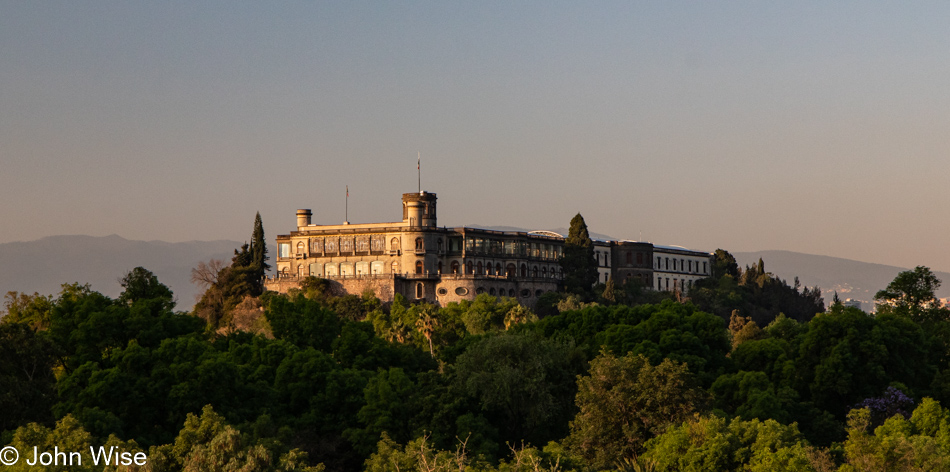
This day stands as the definition of a perfect day. Our first full day in Mexico City and we were blown away. It’s now after 9:00 pm after walking more than 13 miles from our hotel in Polanco over to Centro Historico, and I’m afraid I’m already about to fall behind in my blogging chores as I have my doubts about contending with nearly 500 photos and countless impressions. I don’t believe we wasted a moment, nor did we rest very often, and even when we tried to take our time while eating, impressions were constantly coming on, all of them wonderful.
Waking this morning, we were surprised at how quiet a city of almost 9 million people is, but then, as we were getting ready to head out, we thought we heard drums. Opening our window, and I do want to emphasize fully opening our window here on the 5th floor, no suicide prevention needed here, we looked out at dozens, I mean hundreds, I mean thousands of people running a race. We shut the window and took off for the street to check out the festivities.
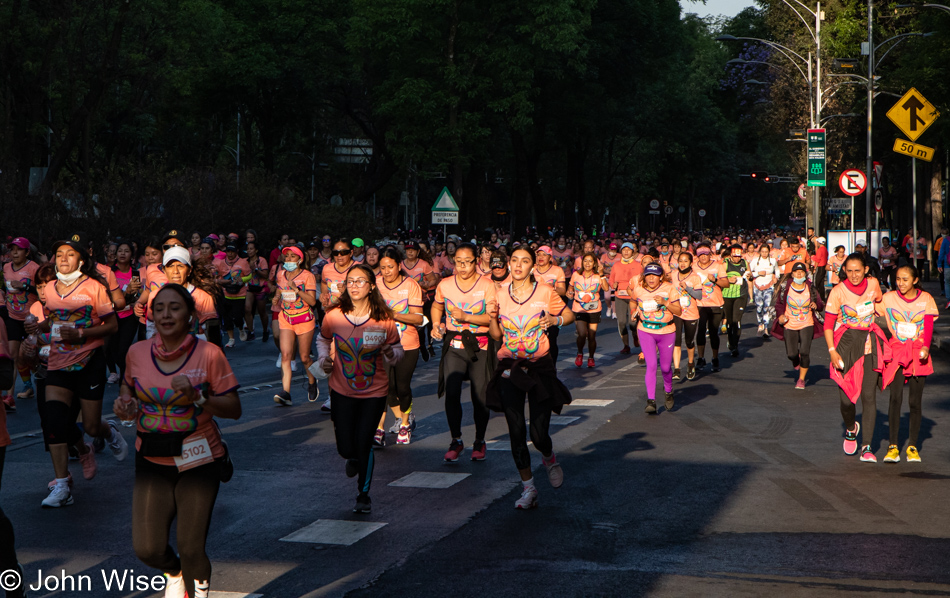
We had nothing to worry about as I miscalculated how many people were on the street; it was easily in the 10’s of thousands, and it was 99% women. We’ve never seen so many women in one place. We still don’t know what they were running for, but later in the day, we’d asked about some blue-steel barricades around most of the monuments in the area and learned that there is a feminism demonstration coming up on Tuesday.
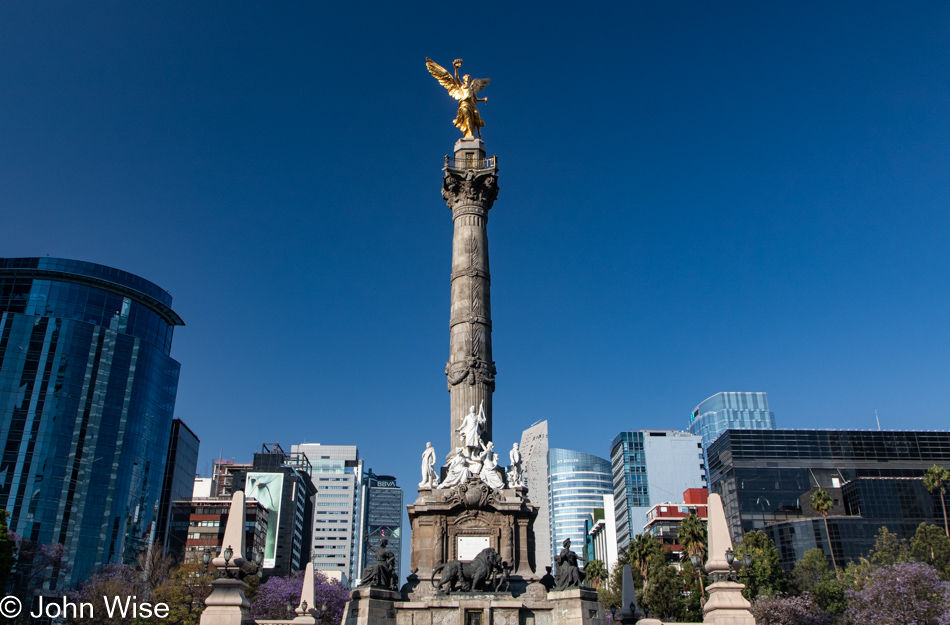
We are walking along the Avenue Paseo de la Reforma on our way towards Centro. This statue is the Angel of Independence, and it was standing guard above the finish line for the race.
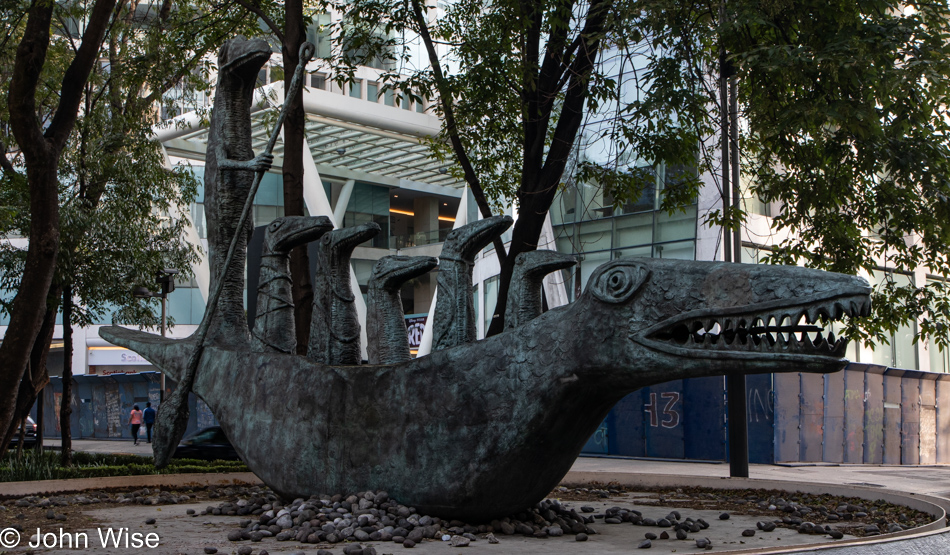
While there are certain areas of Mexico City visitors should avoid, there’s hardly a city in the United States that doesn’t have the exact same kind of issues if you do your research, talk to your hotel staff, and pay attention to the change of character of the place you are walking through; it seems that things are perfectly okay…and often very beautiful.

It turns out that this Sunday morning shutdown of Avenue Paseo de la Reforma is an every Sunday affair to allow the people of Mexico City to bike, run, rollerblade, or just walk along this main artery through the city without worries about cars, buses, or motorcycles threatening people. We’d already been warned prior to coming to Mexico that pedestrians are invisible.
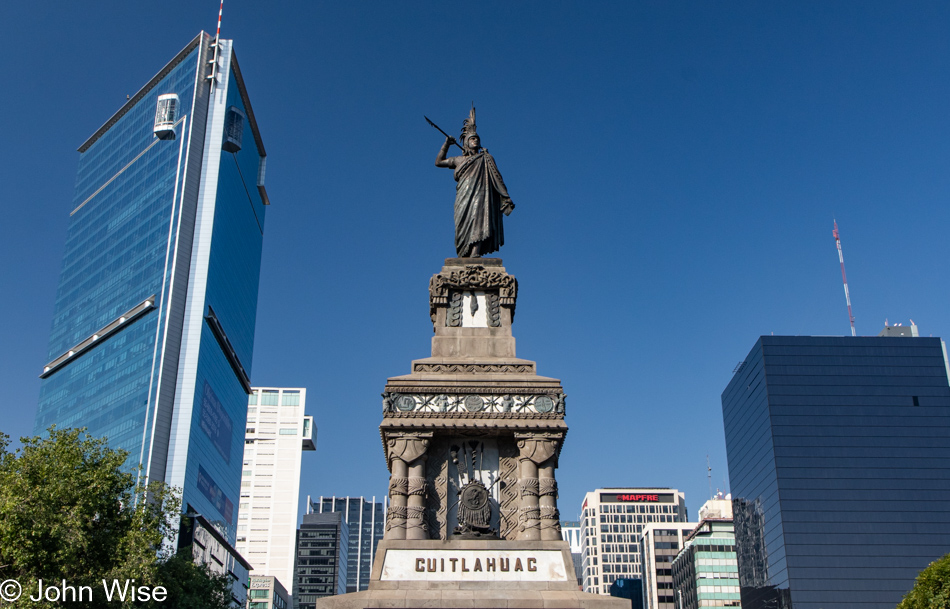
From Wikipedia: Cuitláhuac (Spanish pronunciation: [kwiˈtlawak]) was the 10th Huey Tlatoani (emperor) of the Aztec city of Tenochtitlan for 80 days during the year Two Flint (1520). He is credited with leading the resistance to the Spanish and Tlaxcalteca conquest of the Mexica Empire following the death of his kinsman Moctezuma II.
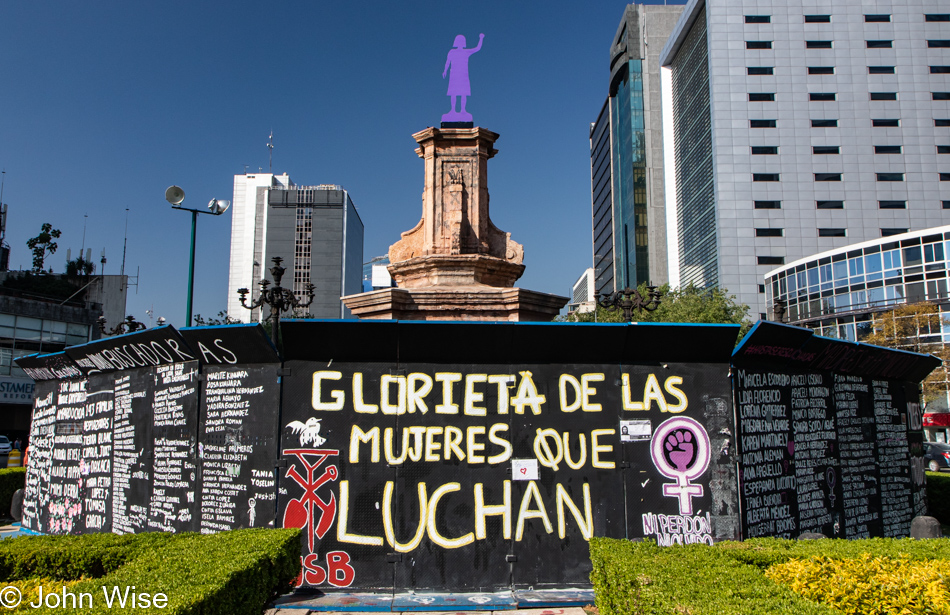
Are the women of Mexico City so inclined to topple and deface monuments to get their point across? Well, from the amount of graffiti on the barricades extolling women’s rights, I’d have to recognize their ambition to get their point across.
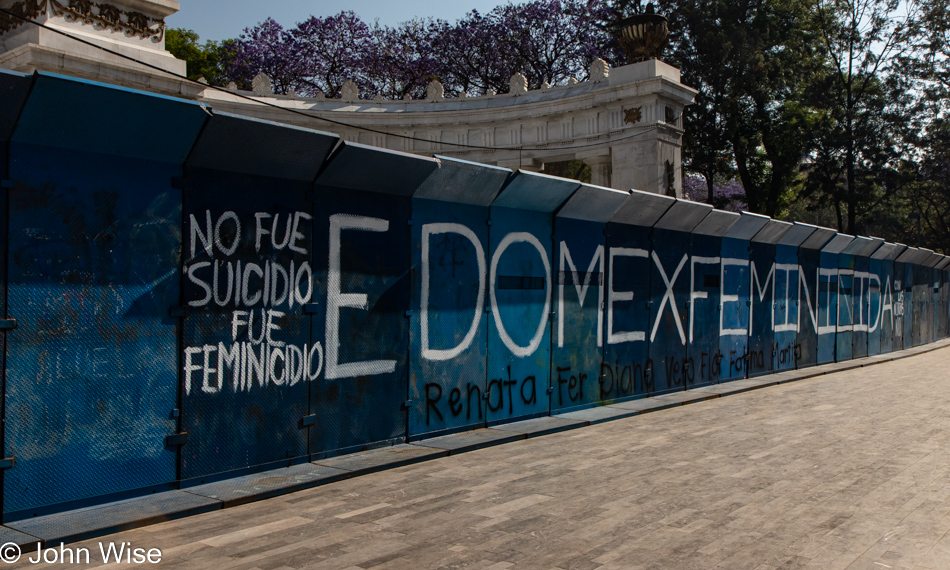
While, on the one hand, our view of the monuments is being restricted, it’s great to know that the opinion of the public is tolerated. I suppose this goes hand in hand with many of the ideas Mexico was founded on, that being that revolution is always respected.
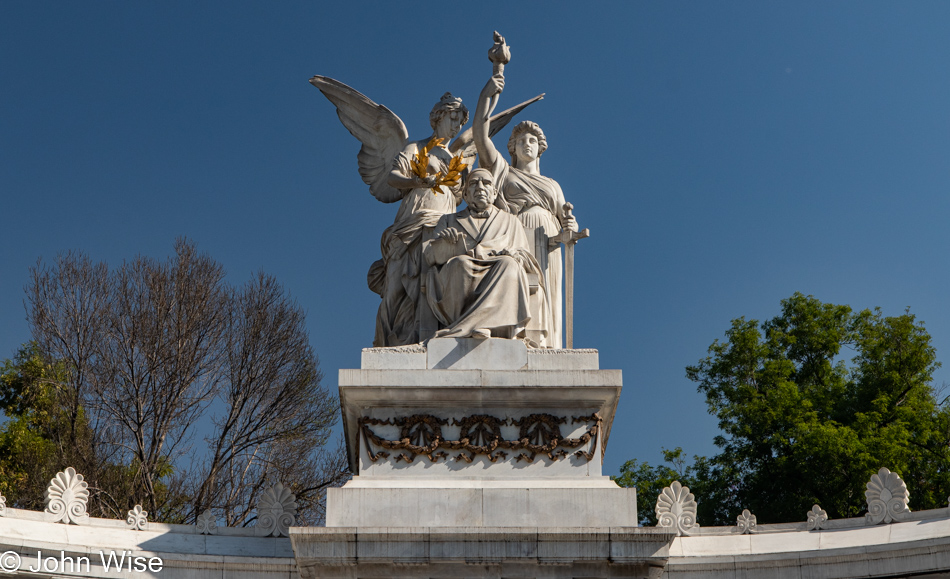
Hovering above the barrier above is this statue of former president Benito Juárez.
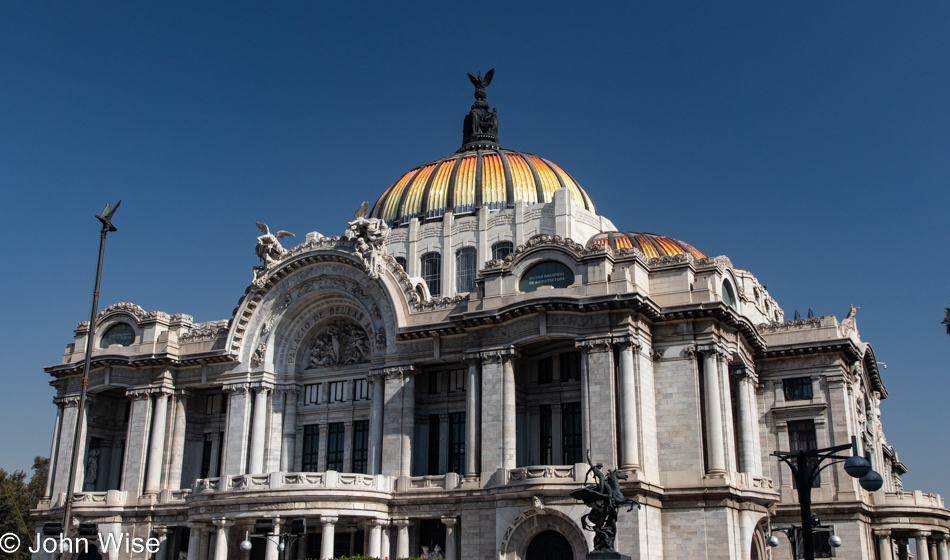
This is the Palacio de Bellas Artes (Palace of Fine Arts) as seen from behind the barrier. Later in the day, we’d visit the grounds, but we wouldn’t have enough time to explore the museum. Walking on, we noticed a campsite of displaced people, apparently from Oaxaca, who were there to protest their situation. We didn’t know it yet, but that was our first run-in with victims of land disputes. Unfortunately, there wasn’t any more information available for us to better understand what was going on.
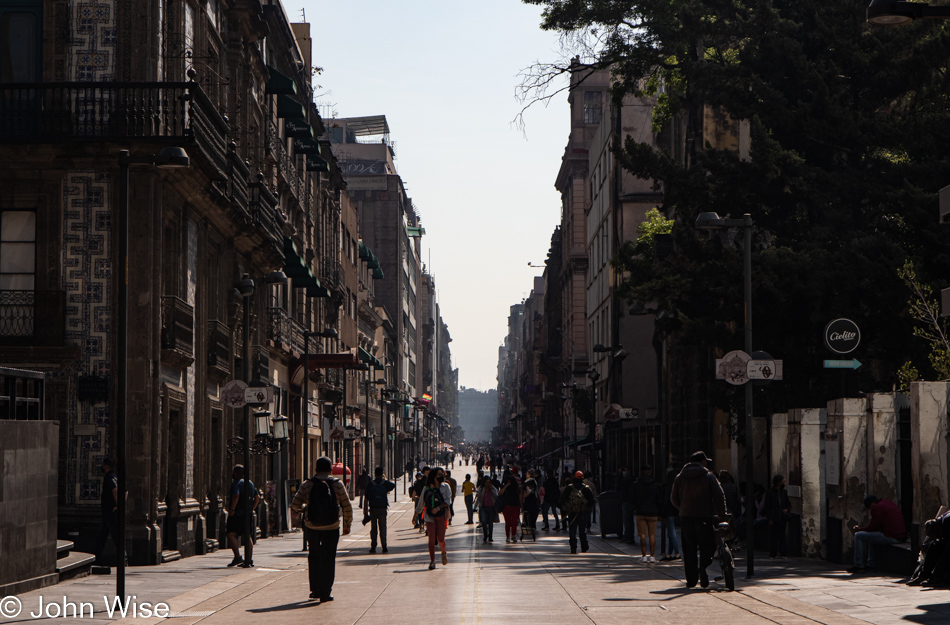
Narrow pedestrian streets in the early morning hold a special appeal that will be missing once the throngs of people hit the shopping passage that is just getting going.
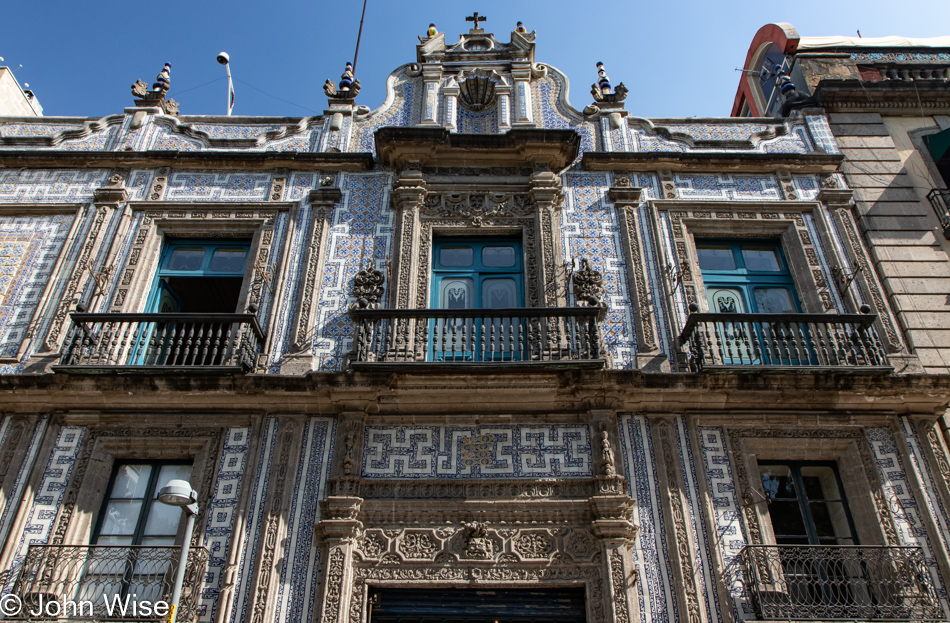
Whatever might have been old on Avenue Paseo de la Reforma is now gone, replaced by modernity for use by the wealthy and powerful while here on Avenue Francisco I. Madero, there are no cars, no new buildings, but there is a McDonald’s without the Golden Arches.
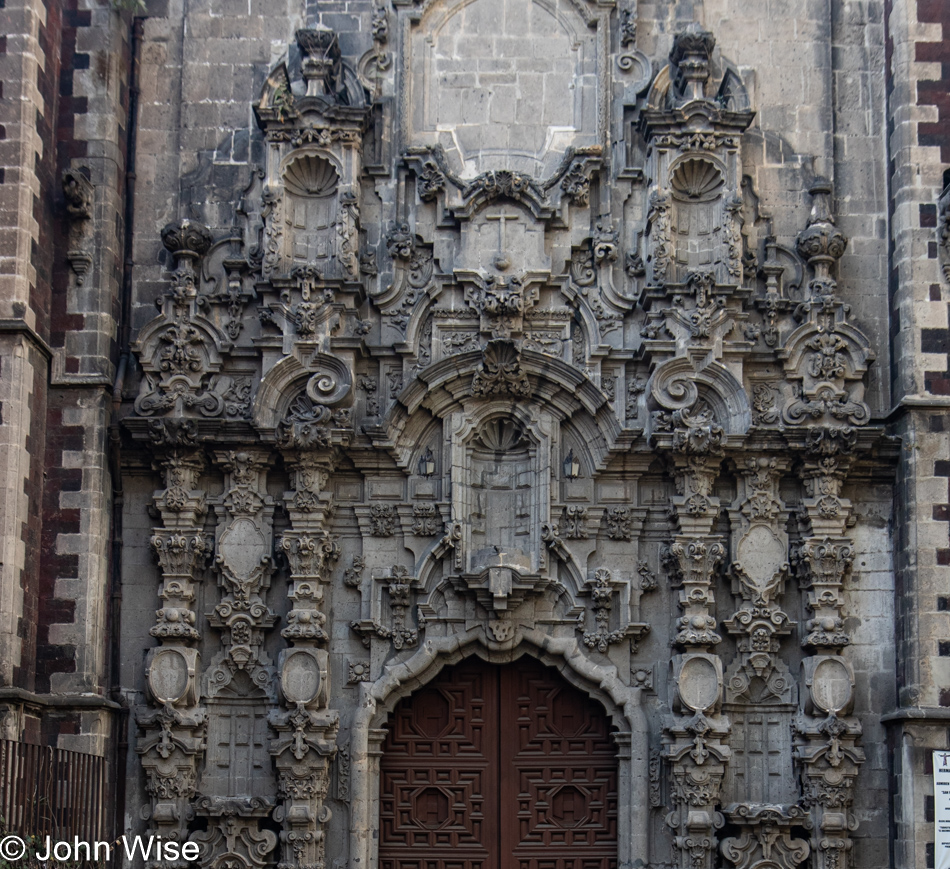
Templo de San Francisco de Asis now has the distinction of being the first church Caroline and I visited in Mexico City; we’ll be sending them a plaque after returning to Phoenix, Arizona, to allow them to share with all future visitors that we were here.
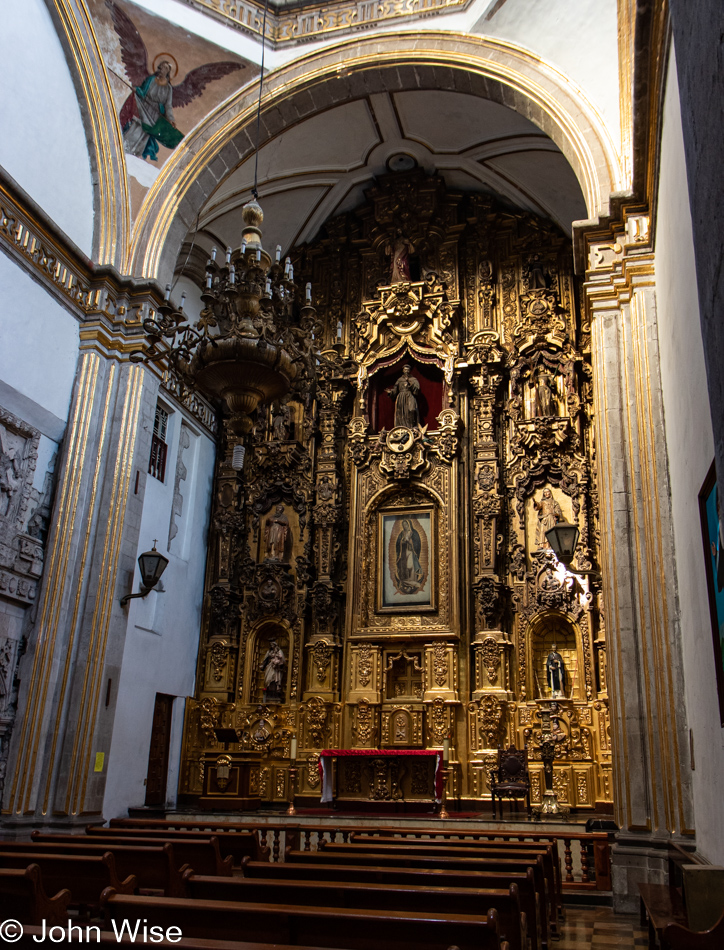
This is the side chapel of Templo de San Francisco de Asis and not the last church we visit today.
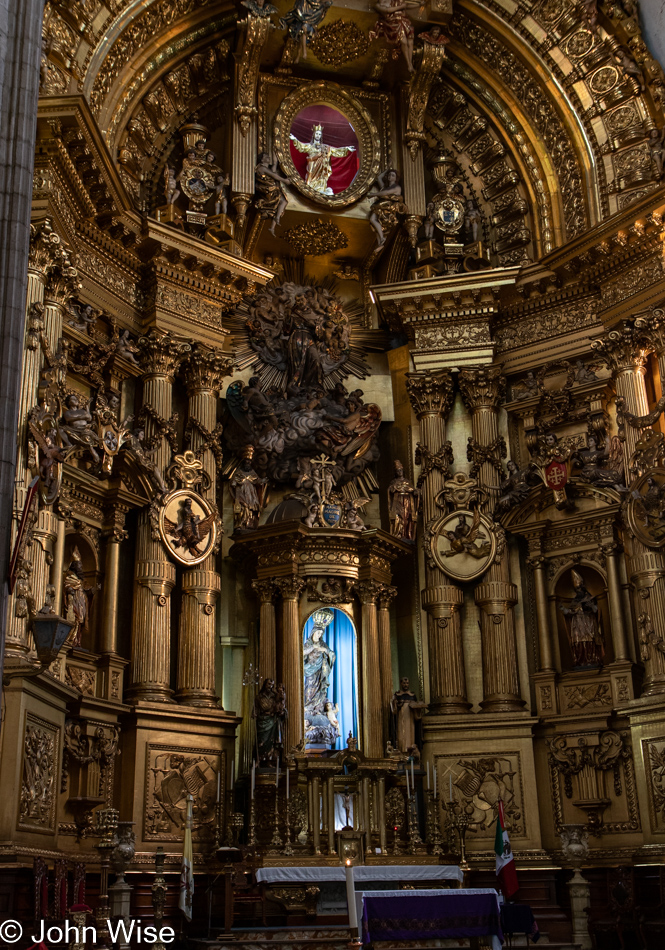
And here is the main altar with the neon gas-encased Virgin Mary. Leaving the church, we walked up to Gante Cafe, which looked popular, so we grabbed a table for a late breakfast of chilaquiles. I wouldn’t have minded stopping at one of the 37 Starbucks along the main avenue, but kept looking for the local options. As it turns out, it doesn’t seem like Mexico City has a lot of independent coffee shops so we ended up dipping into this American institution sooner than we would have thought.
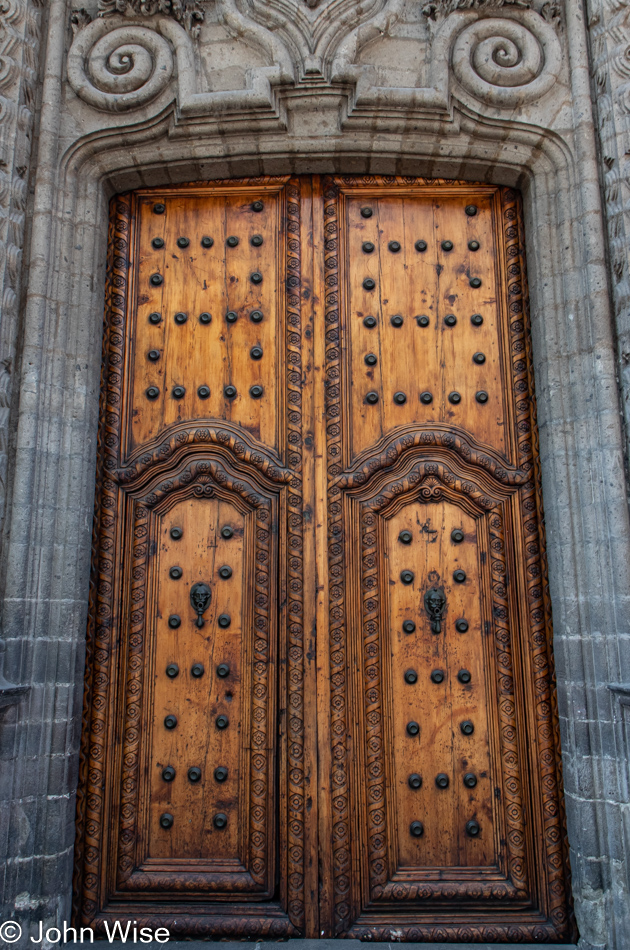
No way these were the doors of a private residence, but sure enough, back in 1822, General Agustin de Iturbide lived here. Who, after Mexico’s secession from Spain in 1821, became part of the regency and was even proclaimed emperor of Mexico for a short time.
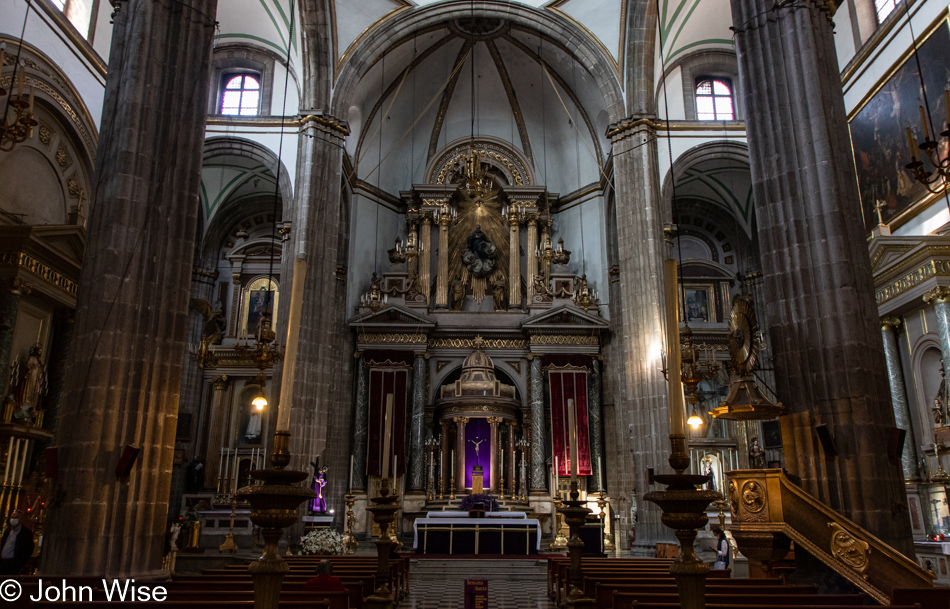
Church of San Felipe Neri “La Profesa” is the location of a conspiracy to bring Agustin Iturbide to power during the Mexican War of Independence as Mexico sought independence from Spain.

Bloody Jesus in a box shackled by the neck might seem like the prize in a box of Mexican breakfast cereal, but this particular sculpture is to be found right here in the Church of San Felipe Neri “La Profesa”

The Church of San Felipe Neri was in no way an easy building to photograph.
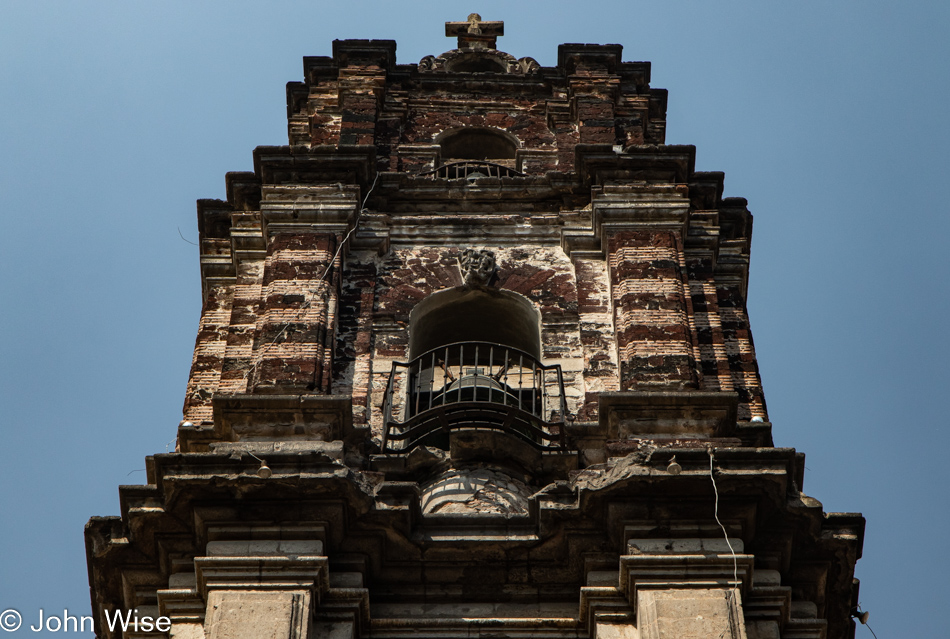
Looking at these treasures of Mexico City, one thing becomes immediately apparent: Mexico needs to invest in protecting these old buildings. That should be high on everyone’s priority list, but then again, I don’t know how much of an economic role tourism plays in this city.

We’ve reached the Plaza de la Constitución, a.k.a. Zócalo, where the first thing that we set our eyes on after taking in the size of the open space was the Mexico City Metropolitan Cathedral of the Assumption of the Most Blessed Virgin Mary into Heaven.
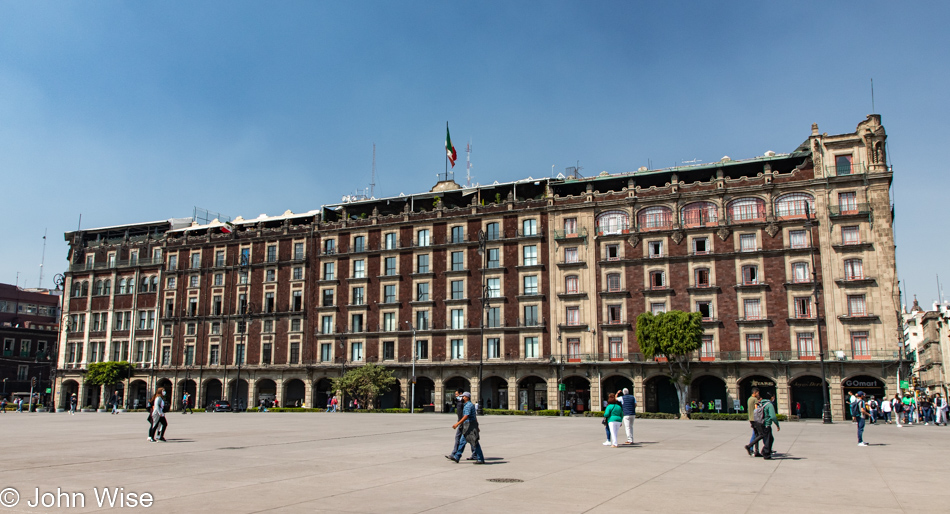
Nothing special here on this side of the Zócalo’. I just like the view and the arcade at street level.
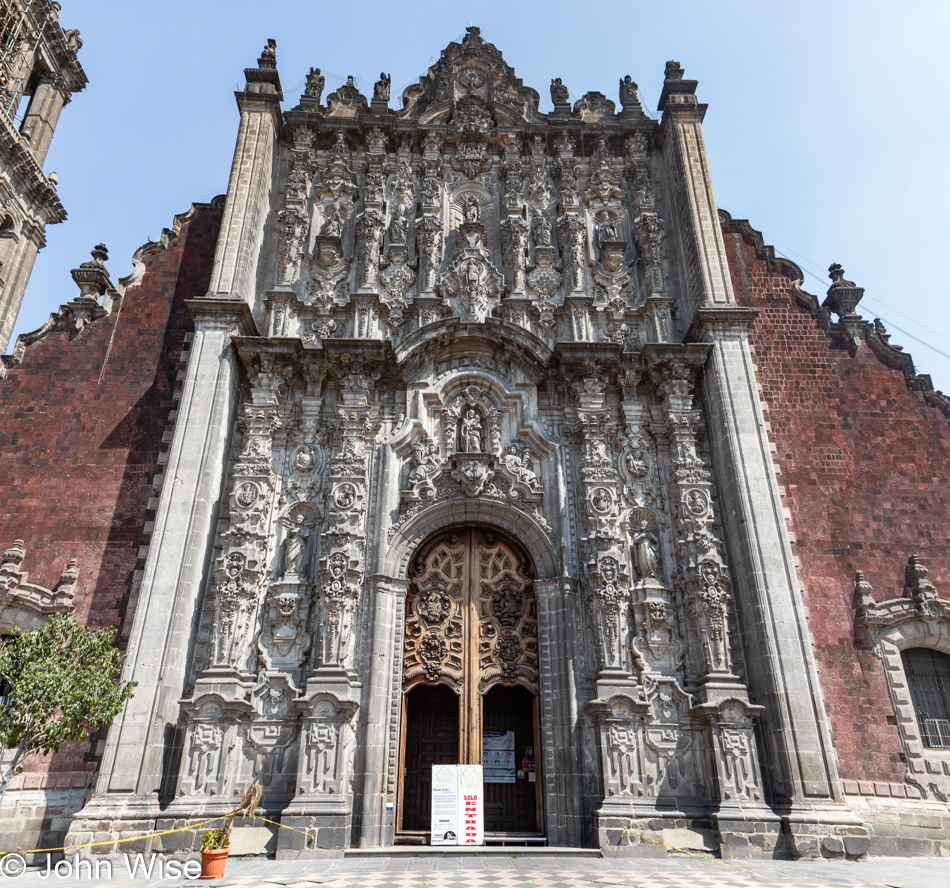
Tabernacle of the Metropolitan Cathedral of the Assumption of the Most Blessed Virgin Mary into Heaven in Mexico City, Mexico, is a mouthful, so how about we are visiting another church.
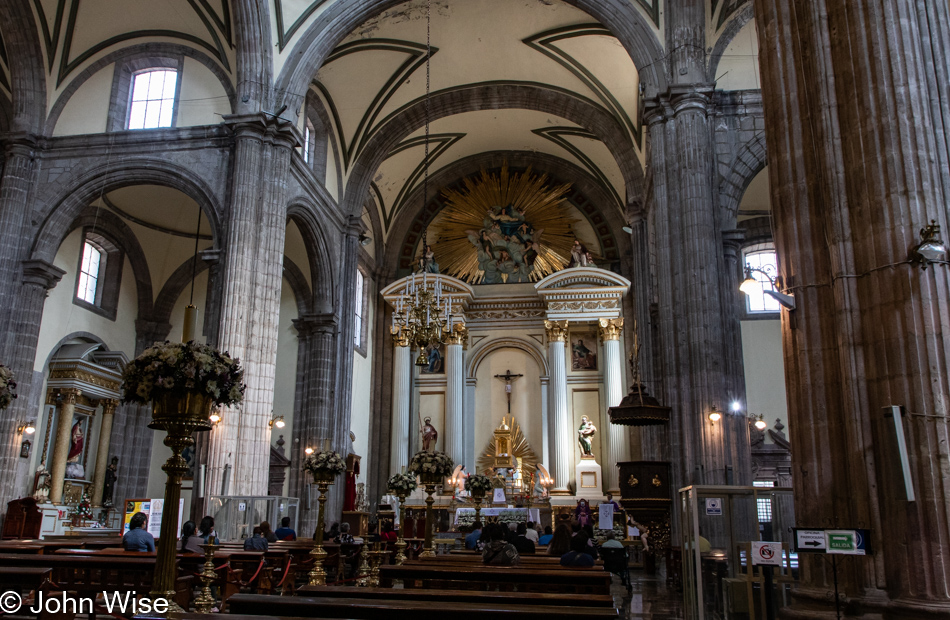
Inside the tabernacle, if this had been the end of our day, we wouldn’t have been disappointed, and yet there were still 4 or 5 days of experience ahead of us on this Sunday.
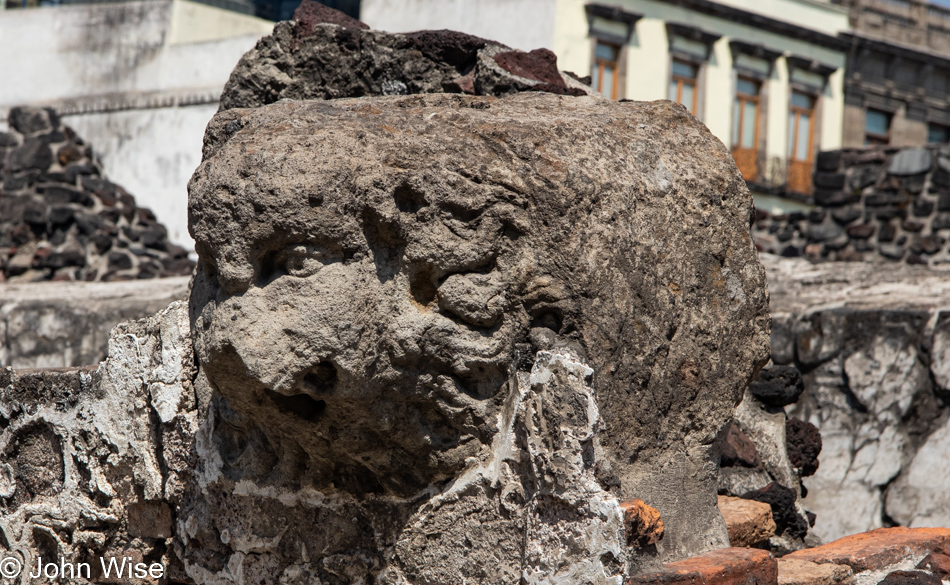
Around the corner of the churches, we’ve reached our main destination, the Templo Mayor, which was called Huēyi Teōcalli in the Nahuatl language back when this was the capital city of Tenochtitlan, now known as Ciudad de Mexico or Mexico City.
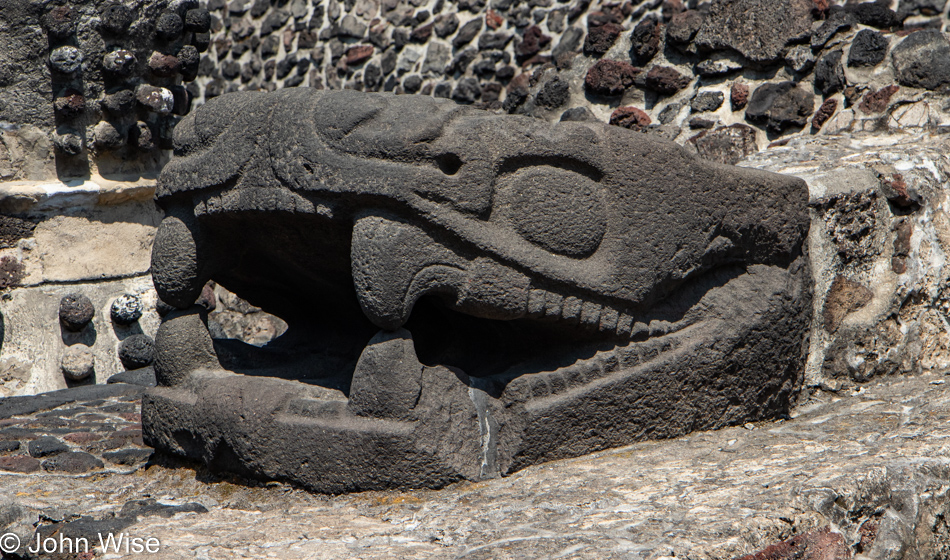
I can’t be certain if this is the first serpent sculpture we’ve ever seen, as there was an exhibit of artifacts from Teotihuacán in Phoenix a few years ago, and they might have included one, but I can’t find a blog entry about those days. In any case, this is certainly the first time I have seen such a sculpture in situ.
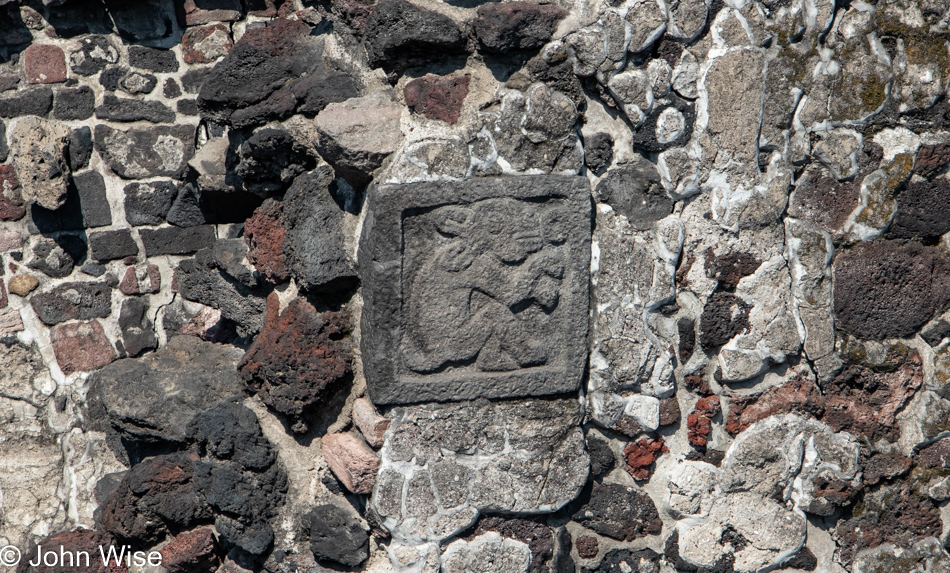
The Conejo or rabbit will be a frequent theme.
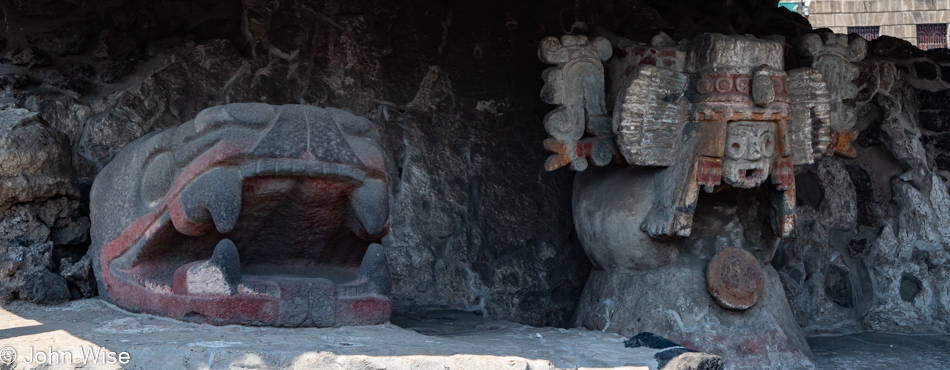
It’s so incredibly fortunate that these still exist, as the Spaniards didn’t leave much standing in their efforts to erase the history of the ancient peoples of these lands. Serpents, pyramids, and multicolored deities where human sacrifice might have been part of the plan weren’t in the Catholic plan of what “normal” life was all about. Maybe some people can take these kinds of moments for granted, but we can’t; it is a privilege to see these things with our own eyes.
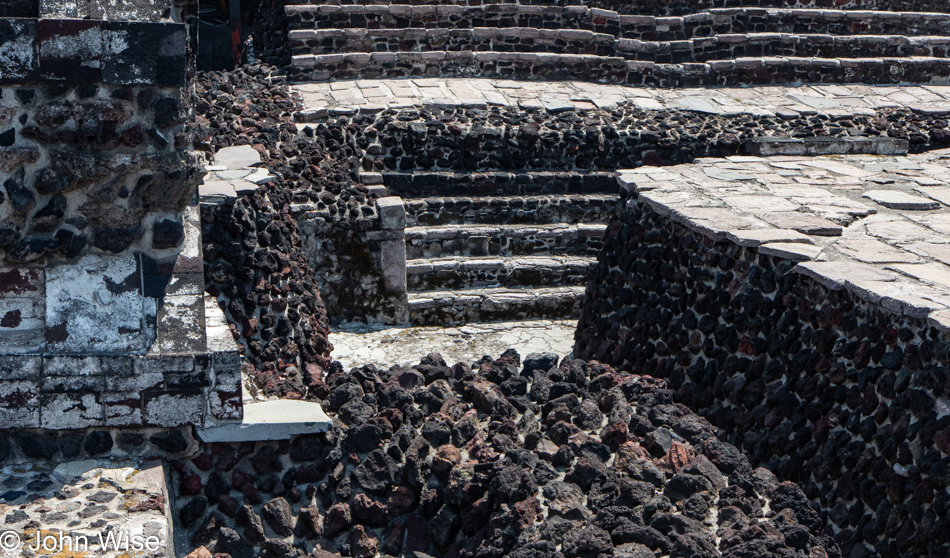
I started out this entry by including an over-abundance of images, and I’m sure many of these had a lot of meaning when I took them, but now, looking at them while I sit in the airport on the way to San Cristobal de las Casas, I know that the stairs and platform felt important due to the contrasting and crooked lines. However, at this moment, it feels like most viewers will just see a mess of stone. You should simply come and see these things for yourself.

No depth creates a bit of a flat image, and seeing this as a photograph, I’m inclined to remove it and the one above, but it isn’t costing anything to leave it where it is, so maybe a dud photo once in a while will better demonstrate the skill I bring to the others.
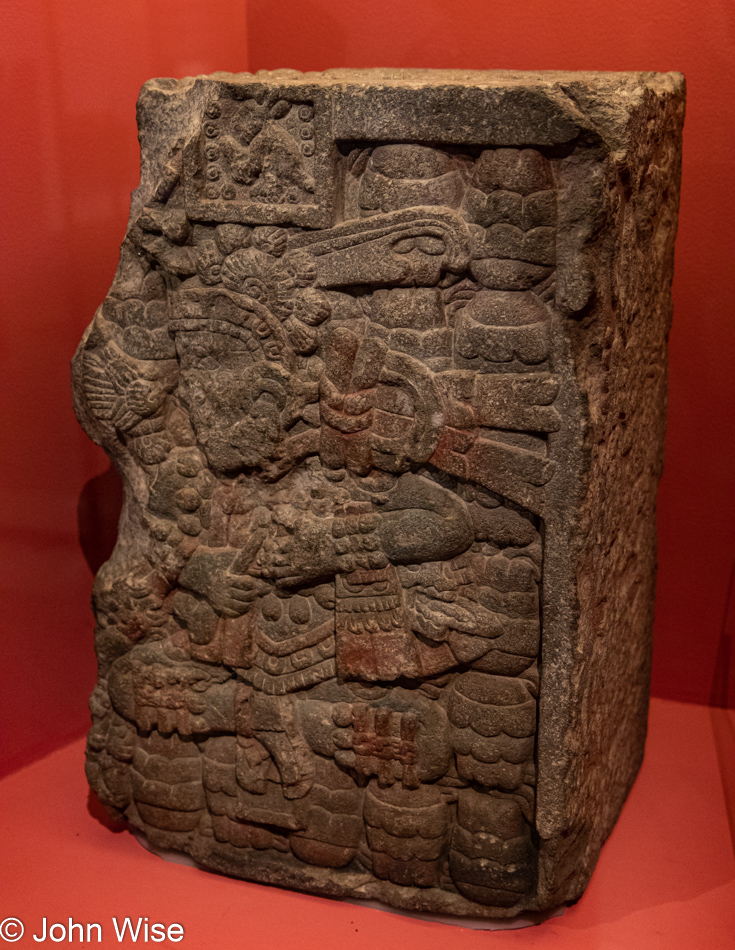
Once in the Templo Mayor Museum itself, it’s as though we dropped through a wormhole and landed in the greatest collection of art that could possibly be assembled regarding this area of Mexico City. Everything I see I want to photograph, but the thought of effectively needing to write a textbook of the inventory in this place is not very appealing. Already, I’ve included far more images than I should have, and over the course of writing and editing this post, I could see paring some of the memories, but then again, I’m a glutton for what these blog posts bring back to us.
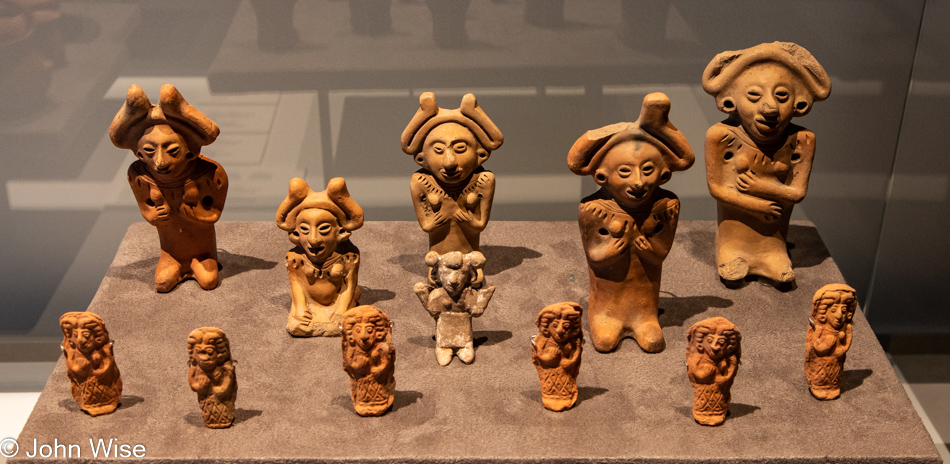
The idea that this pales in comparison to the anthropology museum everyone has raved about to us seems unbelievable right now, especially in light of the fact that absolutely no one has ever spoken of this particular museum. Well, if we should be so lucky, we’ll have a brief window of opportunity to see for ourselves the famous anthropology museum on Tuesday before our flight farther south.
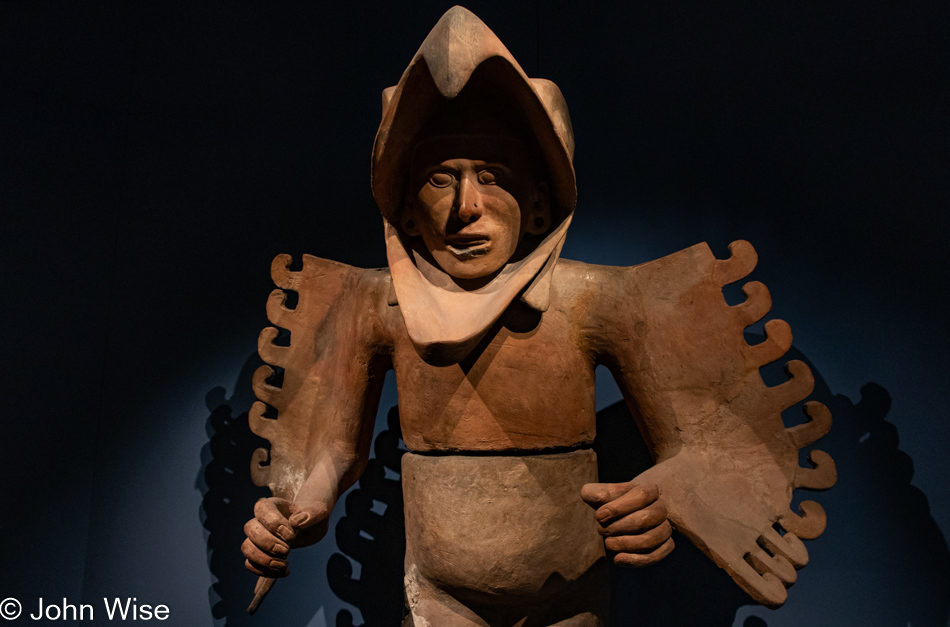
Maybe what is most astonishing about the history represented here is that Rome was just bringing its form of culture to northern Europe, where the inhabitants of Germany were still considered barbarians and had just mastered fire. I’m joking; this was a stab at my wife and her Neanderthal roots. Two thousand years ago, the people of this part of North America were wildly interpreting their place in the universe using complexity, architecture, infrastructure, color, and character that can only arise from deep within the imagination and intellect. This is Cuāuhtli or Eagle Warrior.
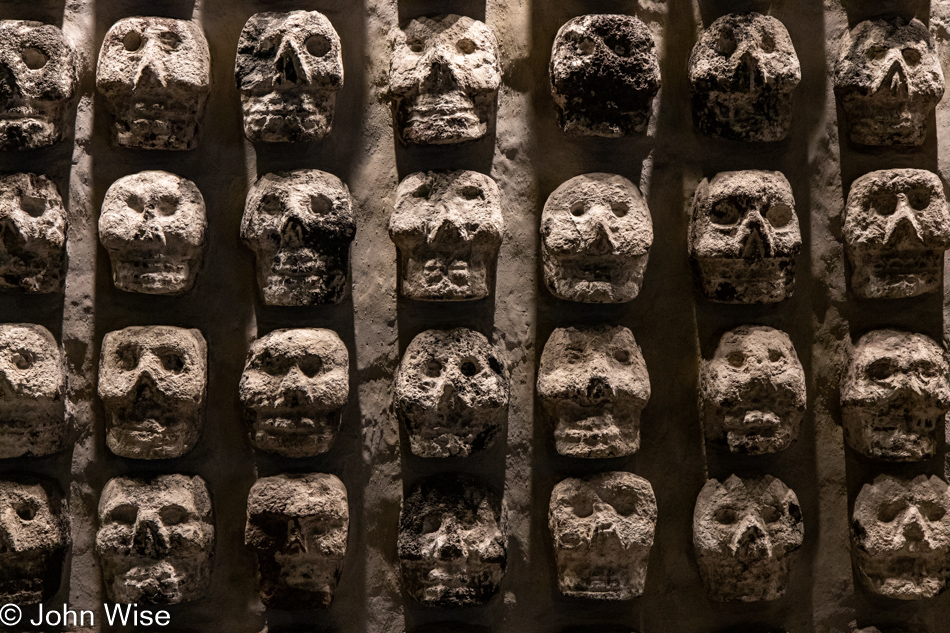
Our pro-European Western bias, when compared to a people’s connection to the cosmos and cycles of life that evolved on this corner of the earth, is an embarrassment to our own ignorance. Why we couldn’t have been taught about the sophisticated cultures that emerged across Mexico and Guatemala I could claim is a mystery, but the reason is obvious: we are part of the ruling white hegemony that feels it would risk its own sense of superiority if we were to validate other cultures and periods in history.
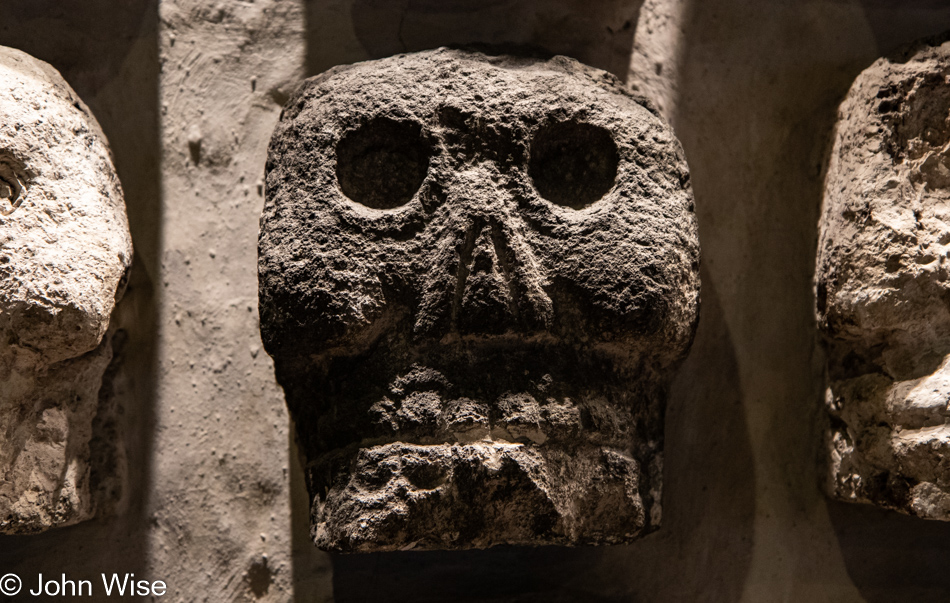
Sure, there’s a historical tragedy that befell the people of central Mexico due to societal collapse possibly brought on by drought, famine, or war, but what nature didn’t squash, the Spaniards did their best to finish off, all in the name of God and Gold.
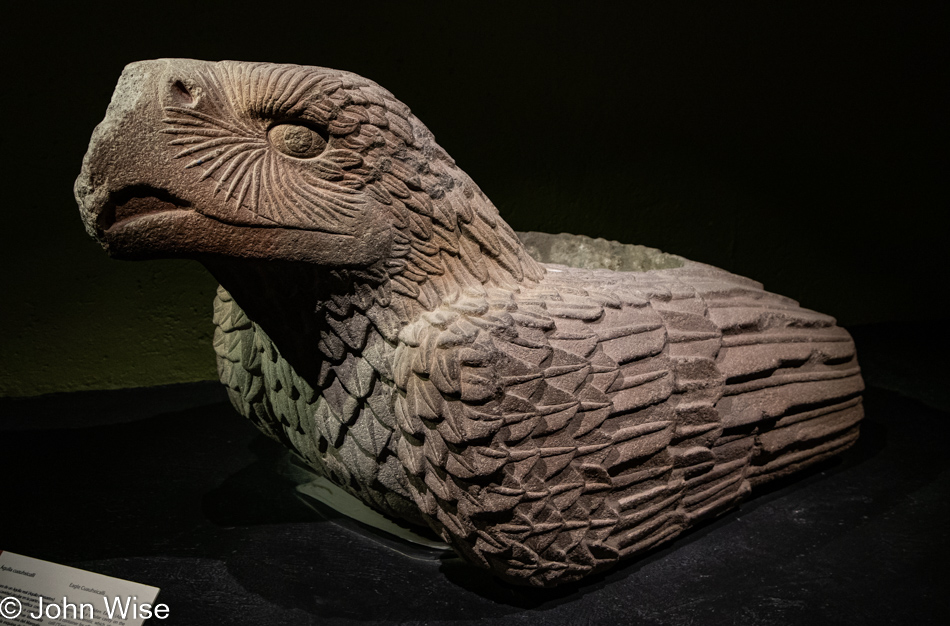
But how often do we find ourselves immersed in the center of such a history to be able to contemplate such questions? I don’t, and if I find myself at the Grand Canyon, in Washington D.C., Yellowstone, or at any other number of destinations in the United States, rarely do I have the opportunity to consider the full scope of an indigenous people where such a prolific society left us so much to think about. Being in Mexico right now, my senses are bombarded from all sides by the sights, sounds, language, tastes, and my own lack of knowledge I found myself in a similar situation when I first landed in Europe back in 1985, and so much was unfamiliar. The sculpture is known as Águila Cuauhxicalli, which translates to Eagle Vessel.
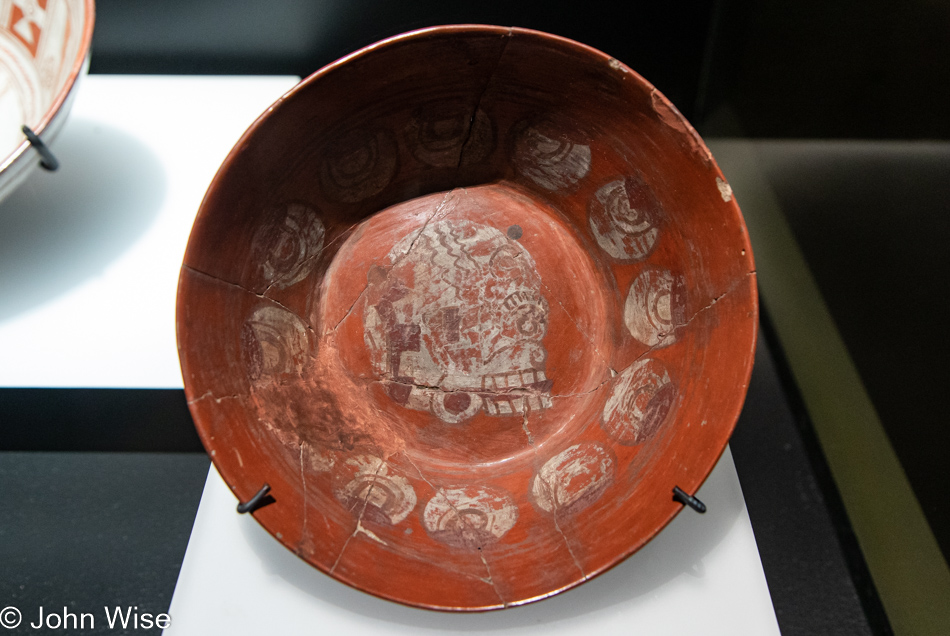
Now that I’m older, I better understand the value afforded me and the rarity of such experiences to be had by people who are curious and humbled by running into the unknown. These pieces of art are not just artifacts; they are the craft and attention of someone giving their lives meaning and celebrating ideas we can no longer relate to. Not that I think it’s impossible to peel the skin of the onion back to peer into the black box of the unknown, but at this juncture, in our collective conscience, we are too afraid to examine the universe through the filter of plants that appeared to facilitate seeing in a different way.

Don’t go thinking that I believe the only way to see truths is through a psychedelic concoction, but just as we experimented on humans trying to repair broken bodies or diseases, I have to wonder why we are so afraid of psychic journeys that could repair things we’ve not yet considered or do the controllers already know what lies beyond the veil and fear for the unraveling of economic enslavement if more people were creating art and exploring rituals that would loosen the bonds of political and religious orthodoxy? This clay vessel is fronted with a sculpture of the Aztec god of rain and thunder, Tlāloc. He is easily recognizable due to his eye goggles and fangs.
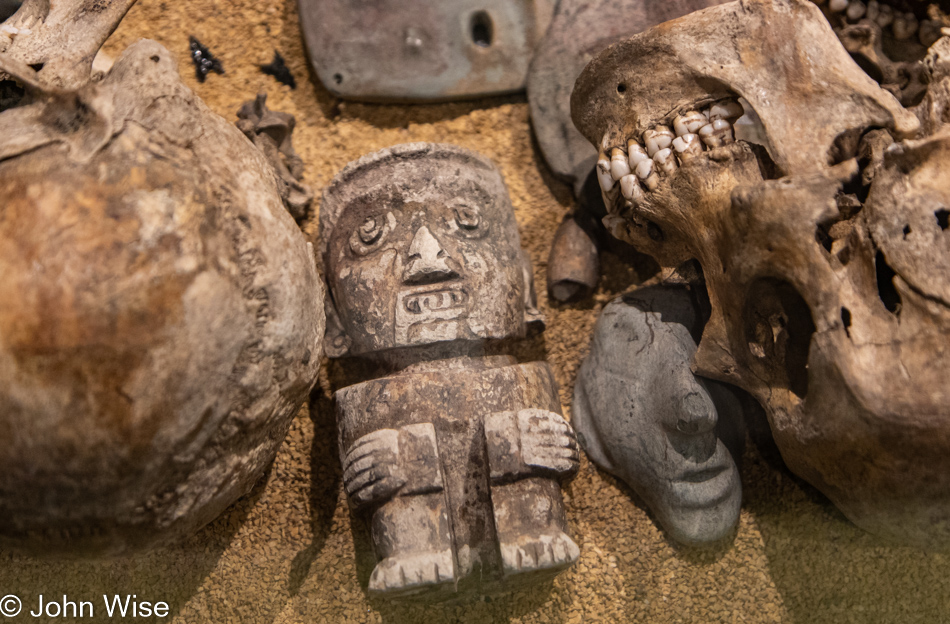
Anyway, I’m currently in the clouds approaching Tuxtla, Mexico, and strange enough, this isn’t the first time this high in the sky that religious thoughts have been with me while aloft. I need to stop writing for now; not that you’ll know any of this without my sharing, but now you know. Hopefully, I’ll return to writing tonight after our taxi ride to San Cristobal, dinner, and check-in to our hotel.
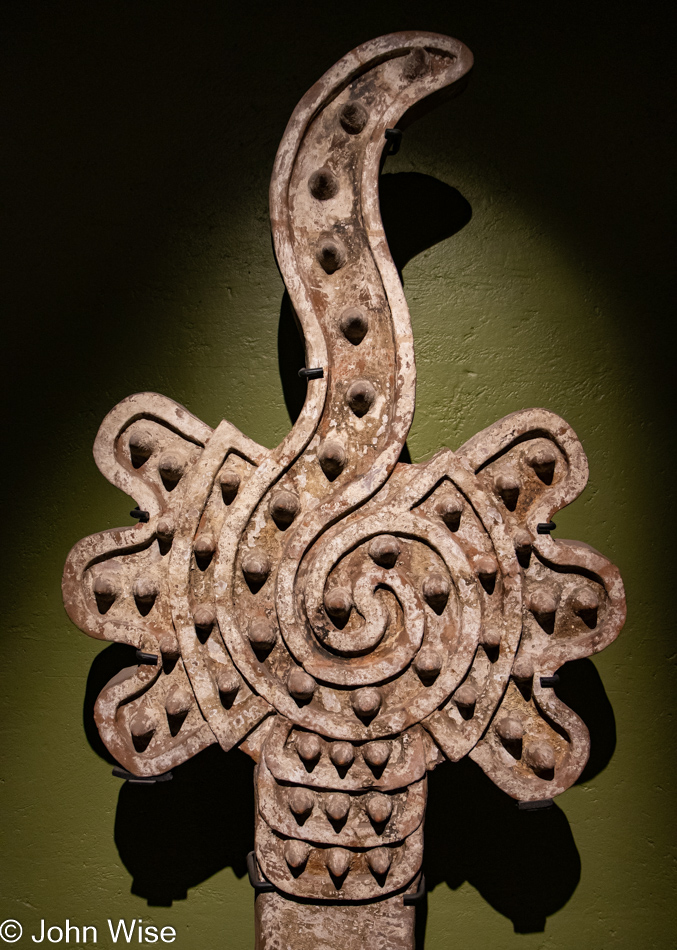
It’s now 20 days later as I turn to these images again. I finished writing about our journey in Chiapas as that was seriously fresh in my imagination, but that leaves me out in the middle of an imaginative desert where I’m having trouble finding something to plant here.
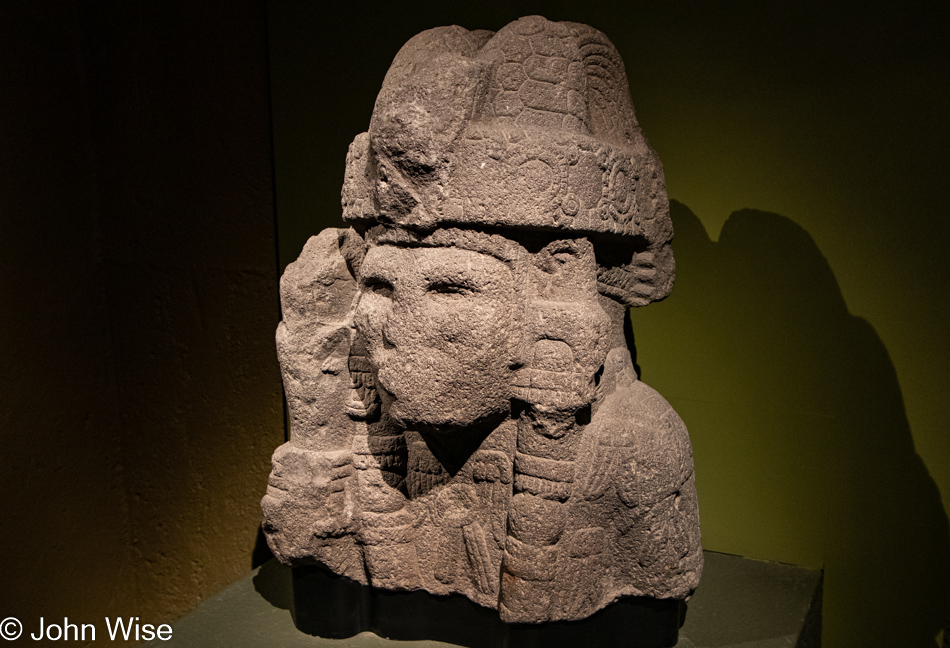
Well, that 20 minutes spent looking up this guy was nearly for nothing, although I did find some info on other sculptures we had the opportunity to see here in Mexico City.
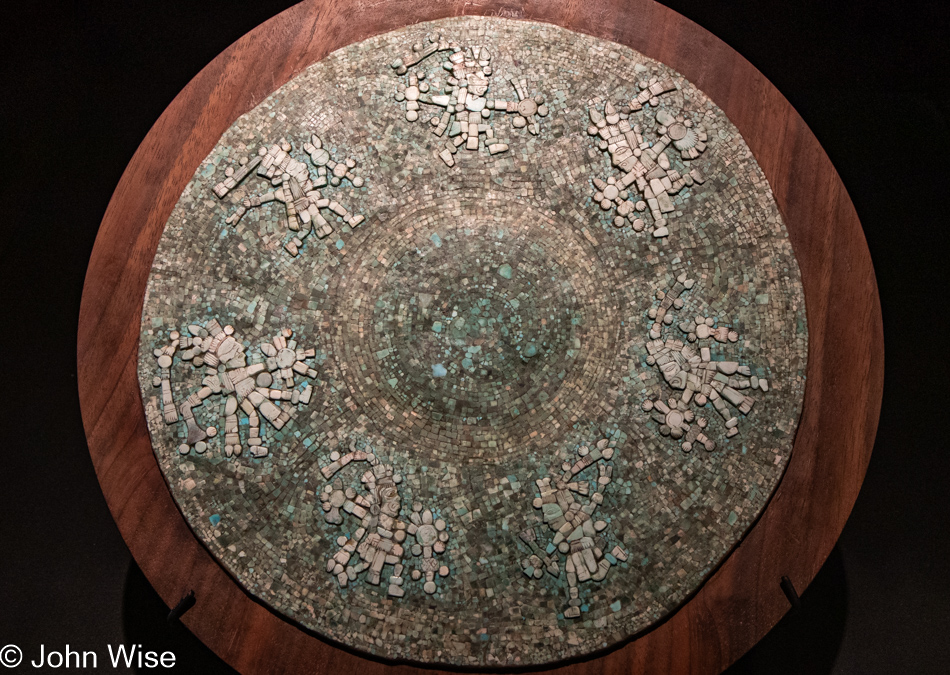
This mosaic is made of more than 15,000 pieces of turquoise.
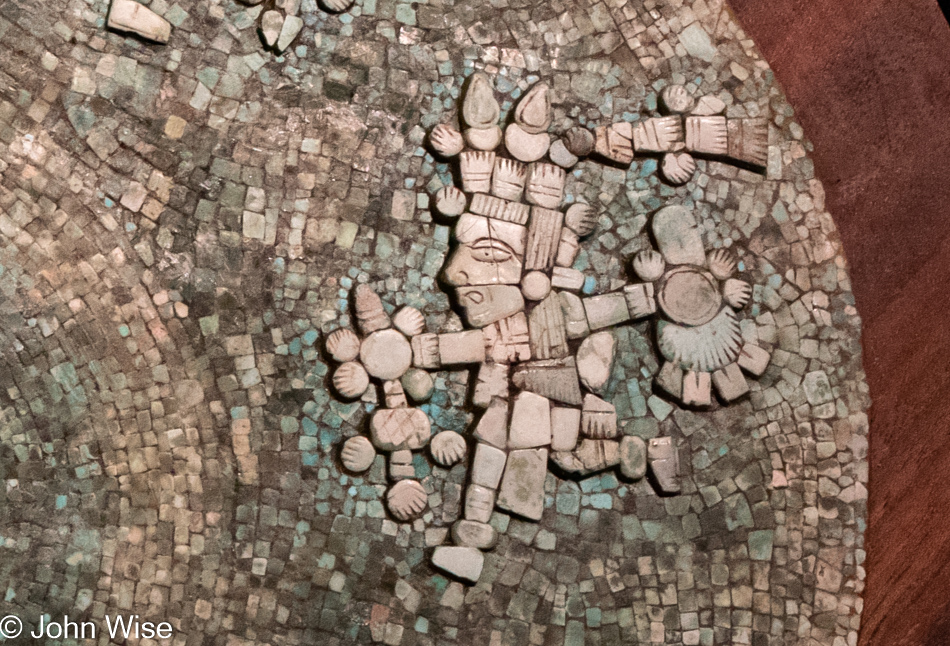
A close-up of the piece just above it. Nothing else to share other than someone else took a close-up of one of the figures when this piece was on display in New York City.
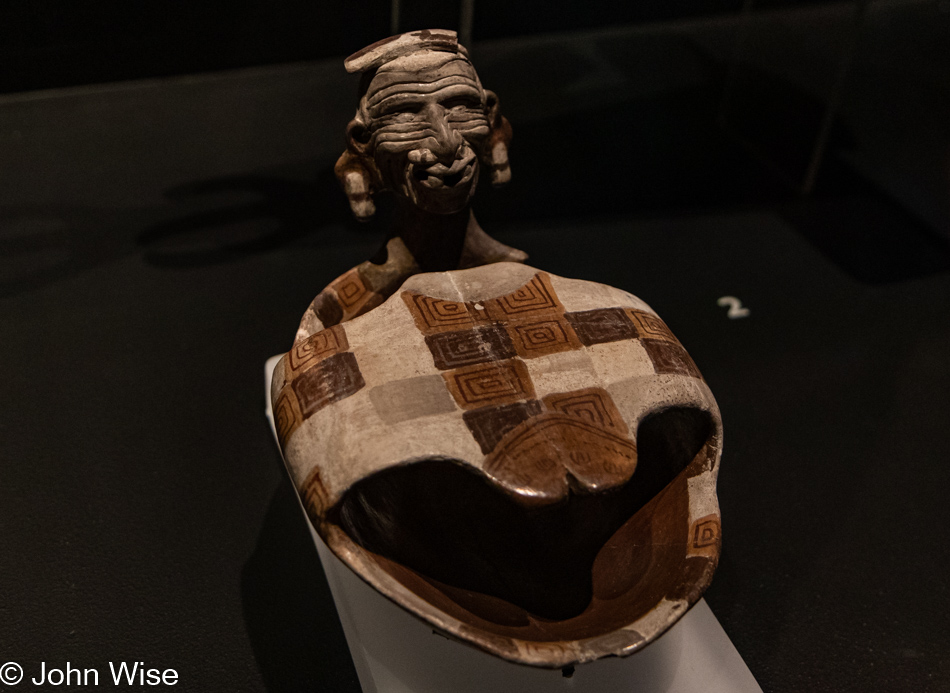
Turtle shell sculpture made in honor of Huehuetéotl, the deity of fire.
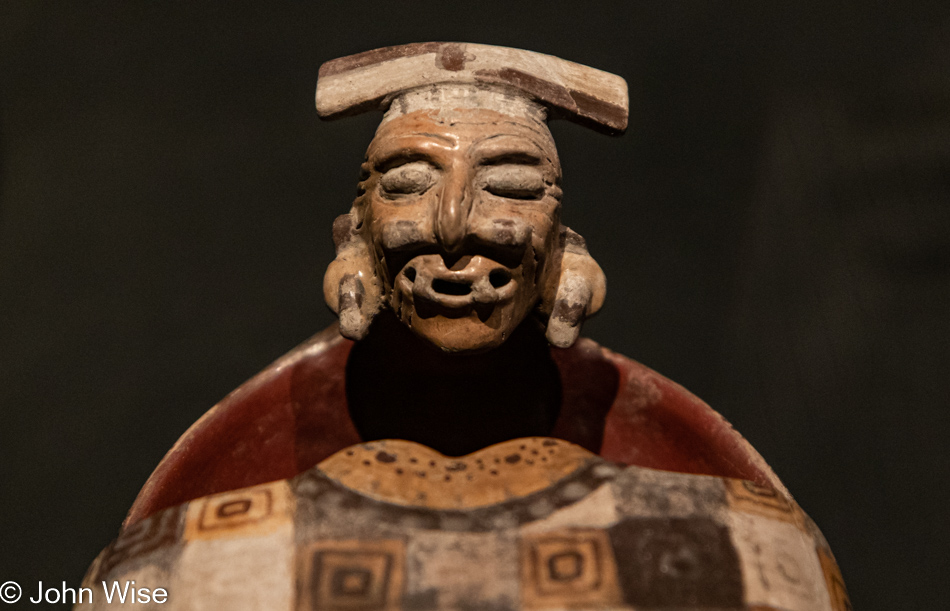
The wrinkled old toothless face is the giveaway that we are looking at, another representation of Huehuetéotl, just as the goggle eyes and fangs are indicative of Tlāloc, the god of rain shown further above.

Burial tombs could be intricate affairs, and when possible, the museum lays them out on display nearly exactly as they were found.

My inner spirit mask.
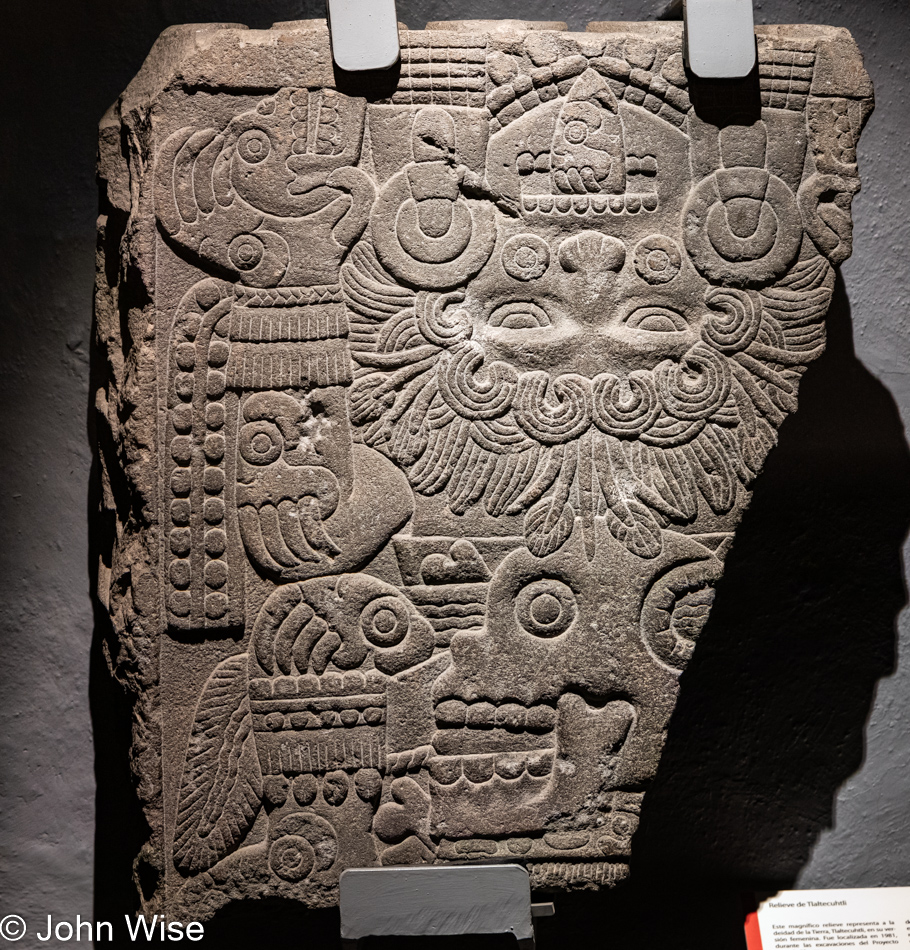
A relief dedicated to Tlaltecuhtli; more about her below.
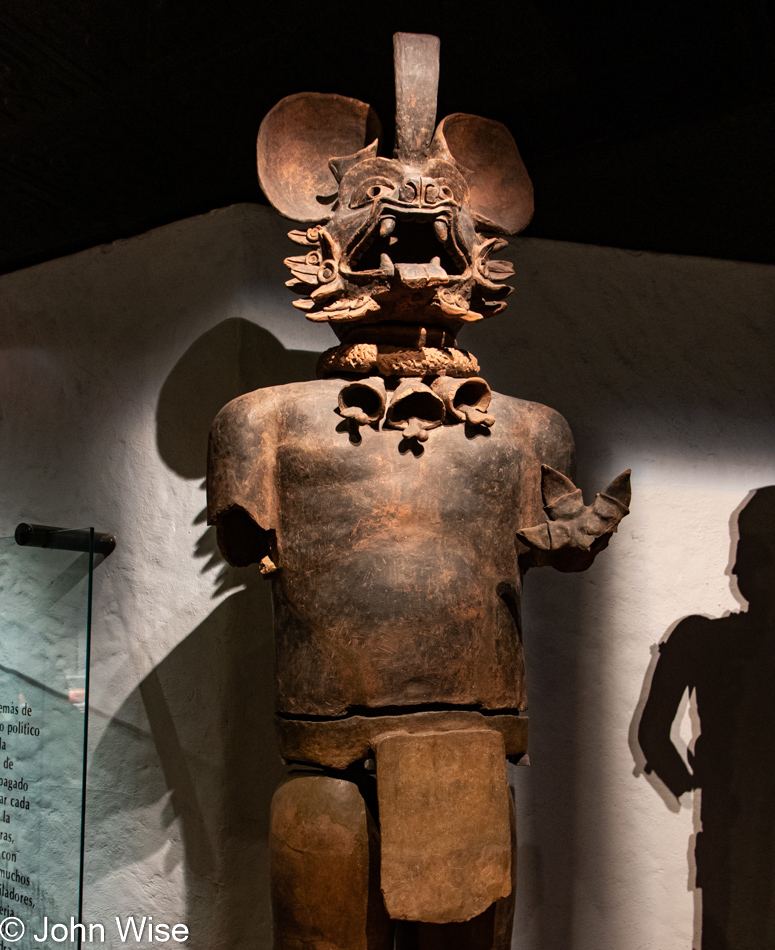
Why has nobody ever made a film featuring Tzinacan, the Aztec bat god? The Maya knew him as Camazotz, and little did we know that we would visit the “place of the bats” (Zinacantán) a week later in Chiapas.
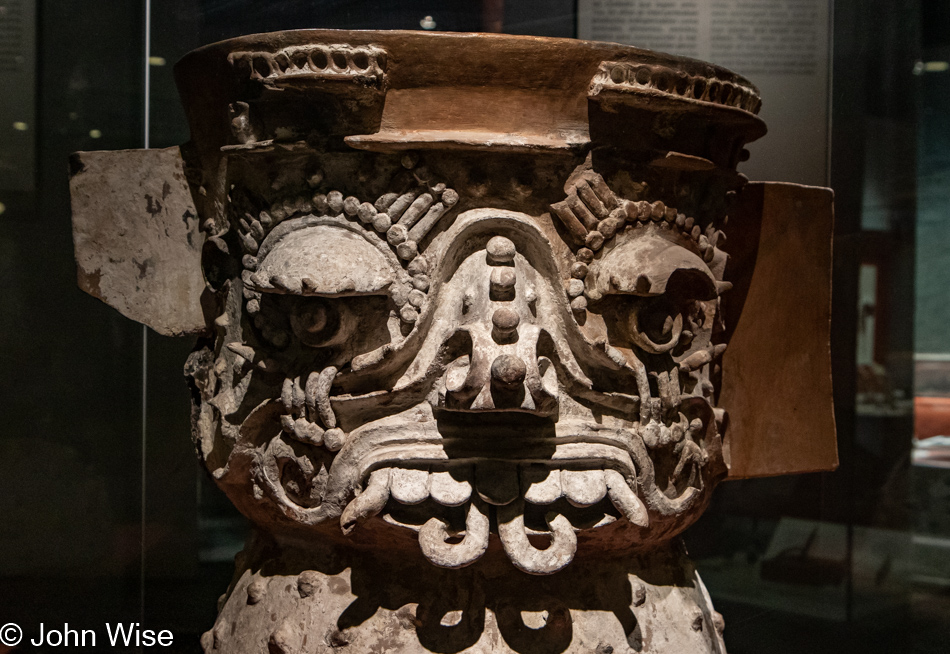
Another variation of Tlāloc, but this one adorns a brazier, though I have no idea what exactly was burned in it. Copal and other resins were popularly used in rituals in the past and are still in use to this day.
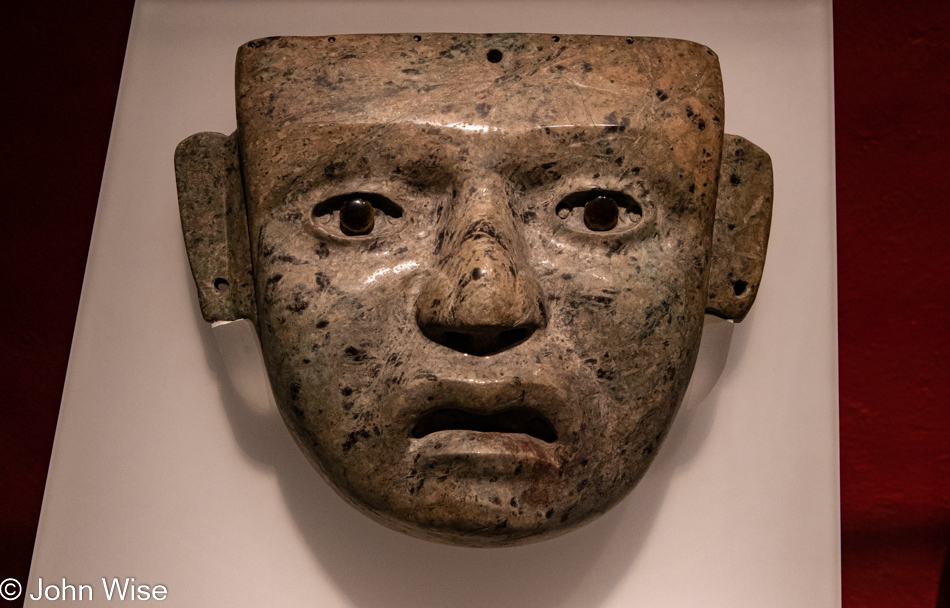
We know that masks have been being used for more than 9,000 years and possibly longer as ones made of wood or other fragile materials wouldn’t have likely survived, but for my dollar, I love these Aztec jade masks on view at the museum.
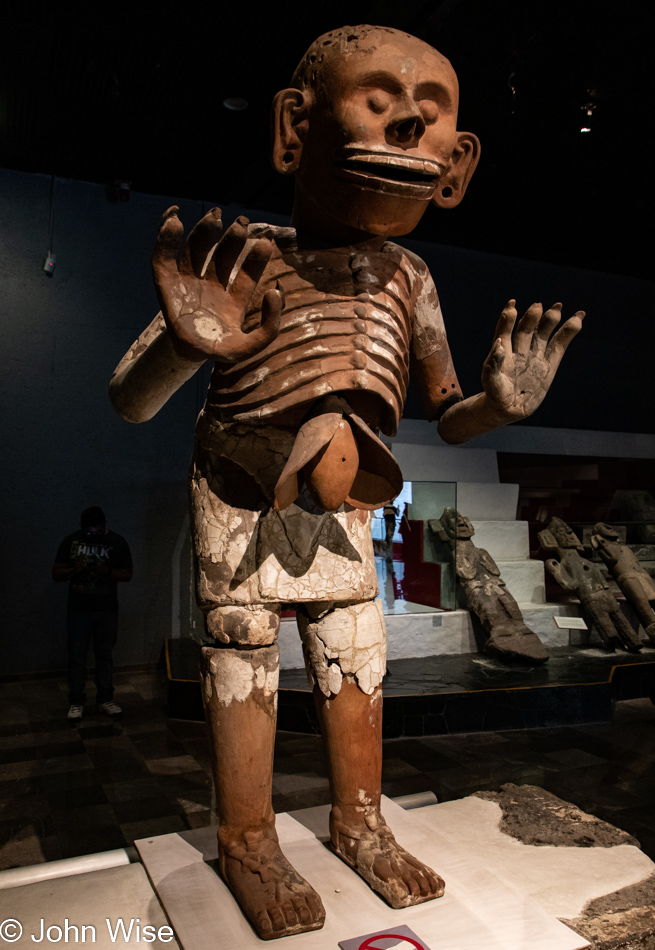
Mitlantecuhtli – The God of Death.
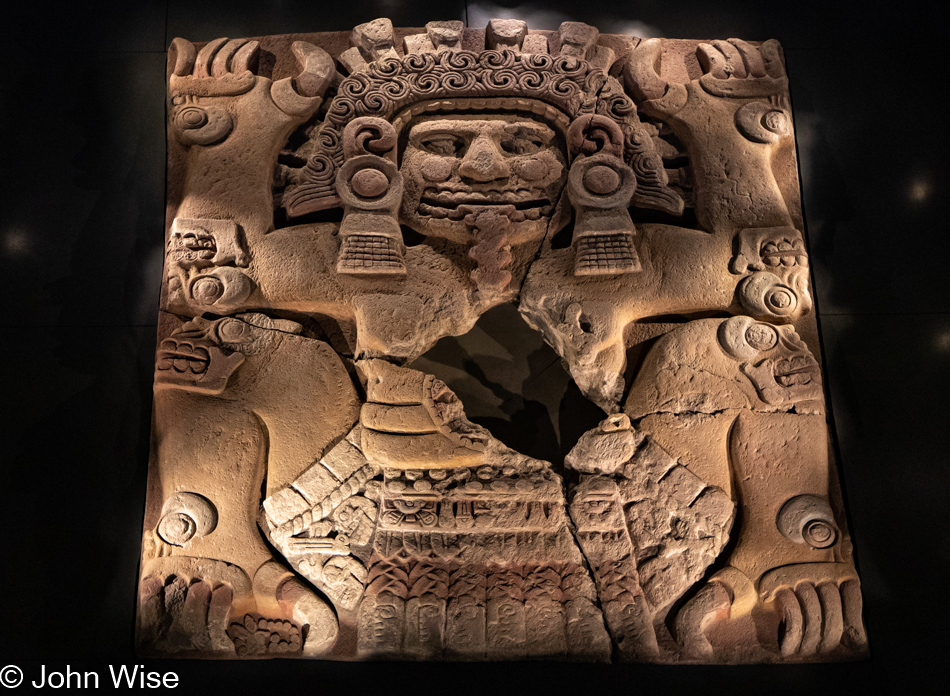
This is Goddess Tlaltecuhtli, who created heaven and the underworld. At some point, there was an image of a person carved into her womb, but I guess it made for an interesting souvenir to someone somewhere in the past.
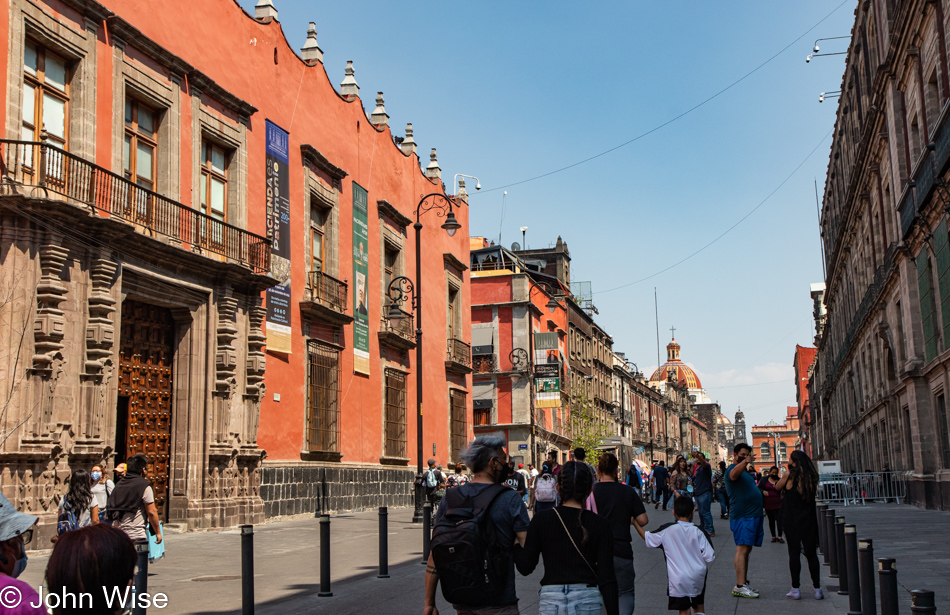
Back out on the streets, everything is as culturally immersive as anything we’re seeing at ruins or in museums.
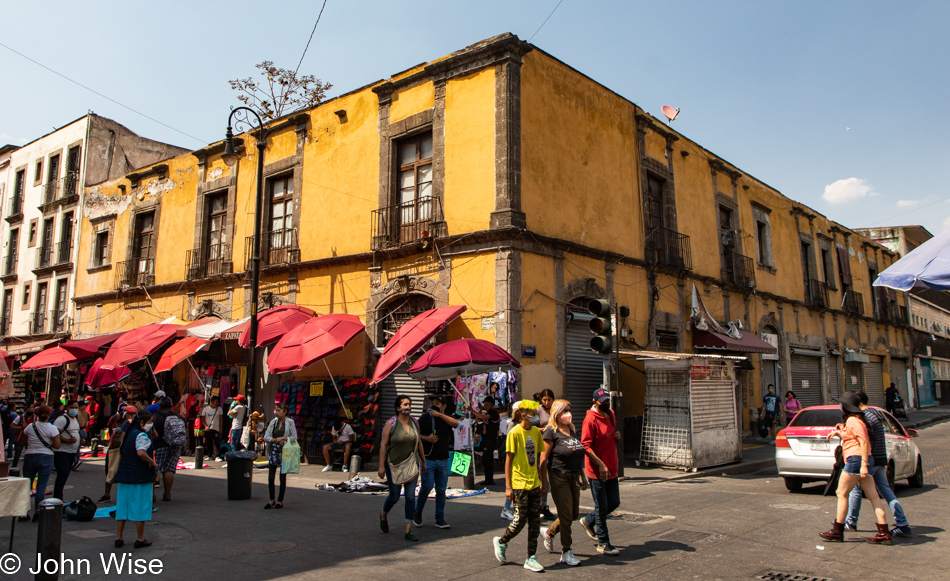
There are many buildings that appear to be returning to dust and look uninhabited until we spot a satellite dish adjacent to a tree growing out of the roof and, below that, an open window that shows signs of occupants.
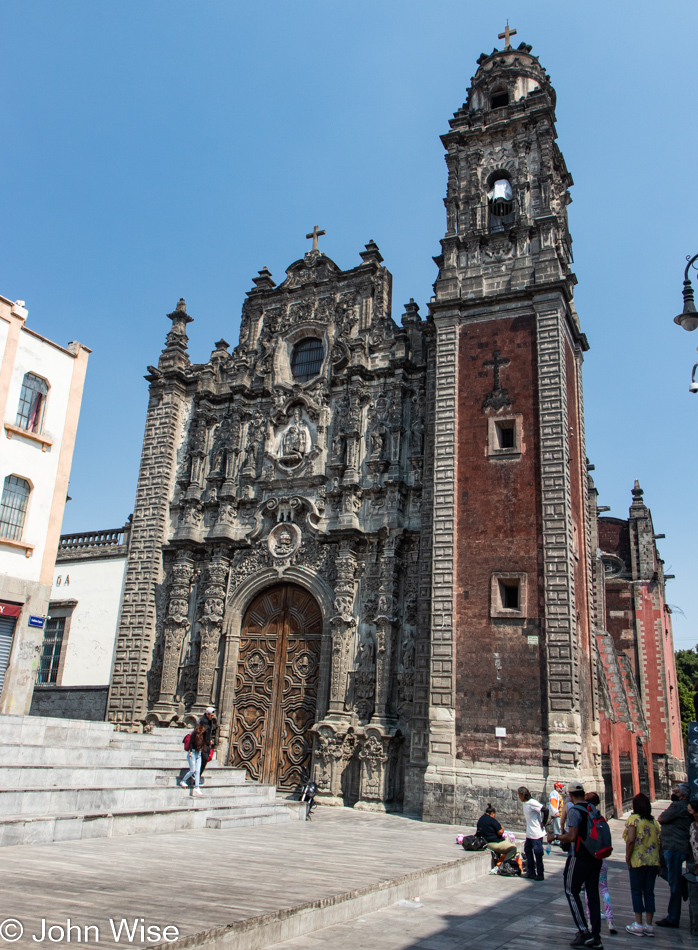
This is the La Santísima Church or Church and Hospital of the Most Holy Trinity; it’s been standing here since 1783.
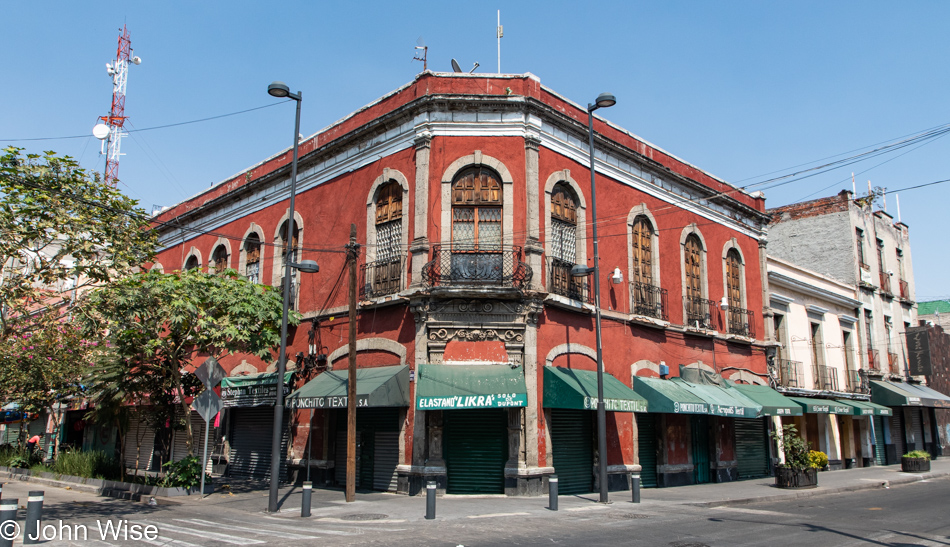
Trying to move away from the crowded streets, it was easy to find what we were looking for, though the fear level goes up in the fear that the media stories we hear in the United States will come true, “Two Caucasians walking in a deserted area show up dead in an alleyway, victims of their own stupidity.”
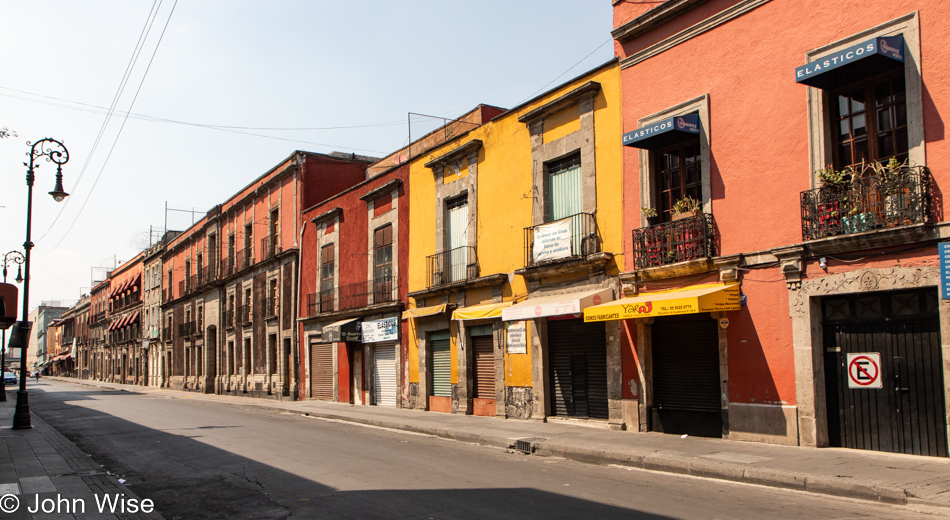
Yep, nobody else out here but us.
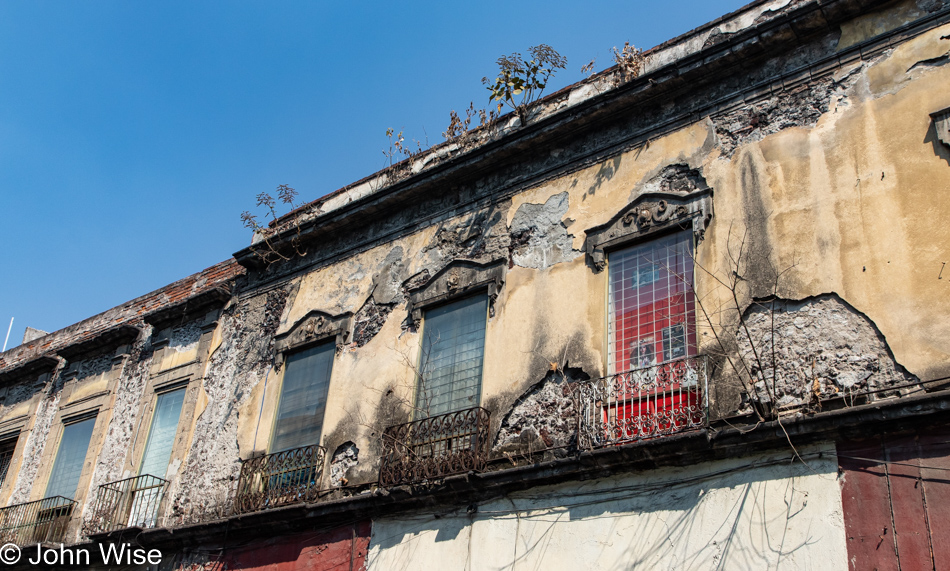
Occupied or not? We couldn’t tell.
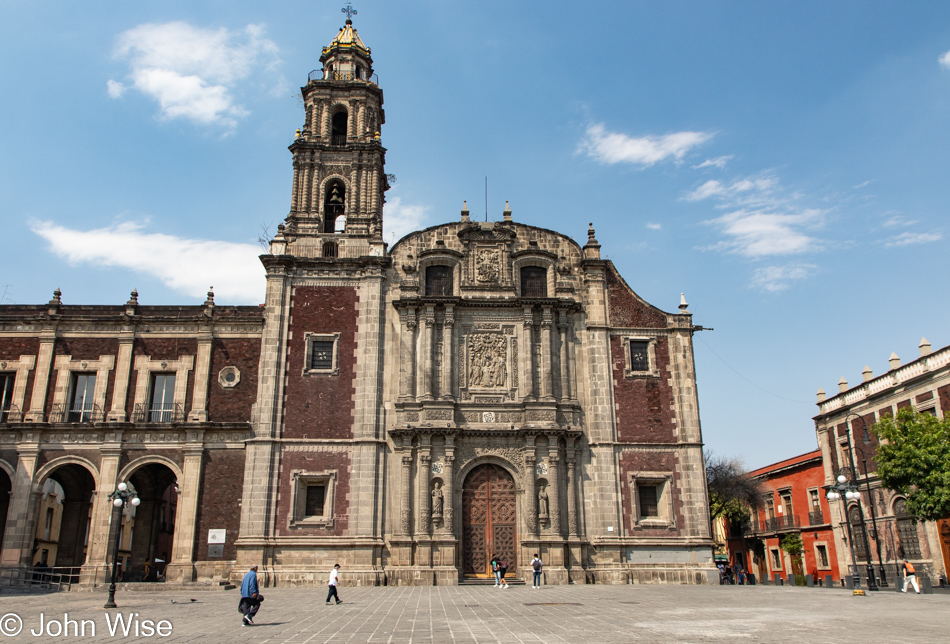
We were minutes too late to enter the Church Of Santo Domingo; maybe next time. Not that luck wasn’t on our side; across from the church was a hopping food stand with no less than a dozen people sitting on small chairs and overturned buckets eating what we, too, were about to have for lunch. Heeding the admonitions to avoid street food was just thrown out the window. The verdict was a resounding wow.
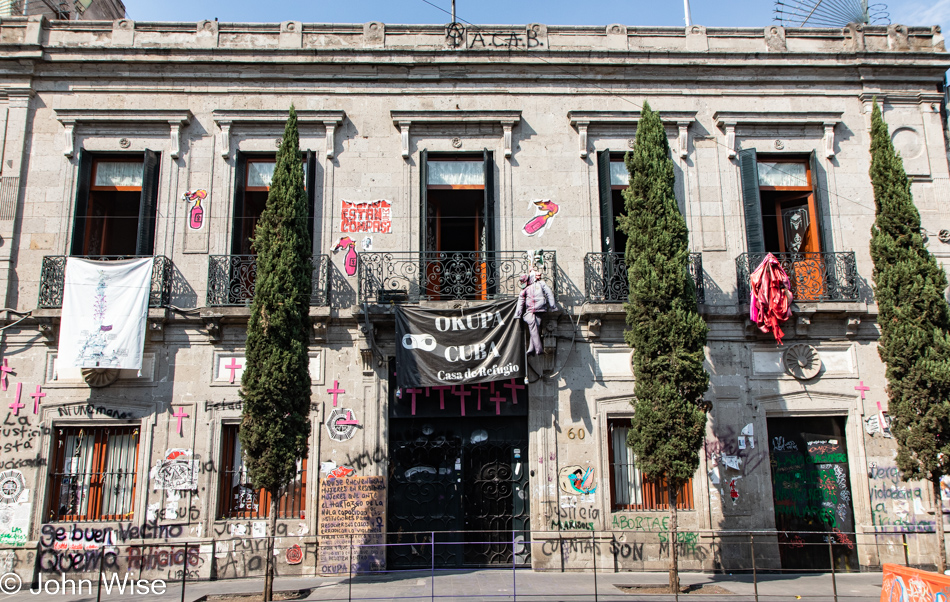
I had to get back to Phoenix, Arizona, before I learned that Okupa Cuba is a Black Block group of feminists supporting women and children who are victims of violence. Could anyone imagine a squat happening in the United States for an extended period of time?
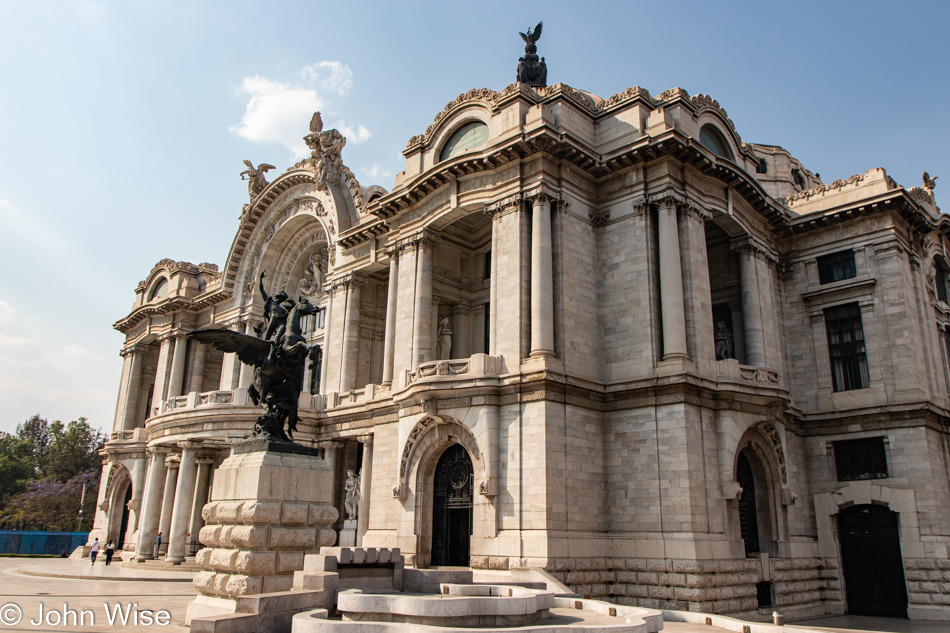
Earlier in the day, I tried to take a photo of the Palace of Fine Arts, but with the barrier around it, I figured that it was the best I’d be able to get today. Well, here we are on the grounds, but our feet are tired after walking more than a dozen miles today already and a few more to go before getting back to our hotel. We’ll put it on the list of the many places we need to come back to here in Mexico City.

Band practice in the park, we couldn’t have been the only ones enjoying the free entertainment.
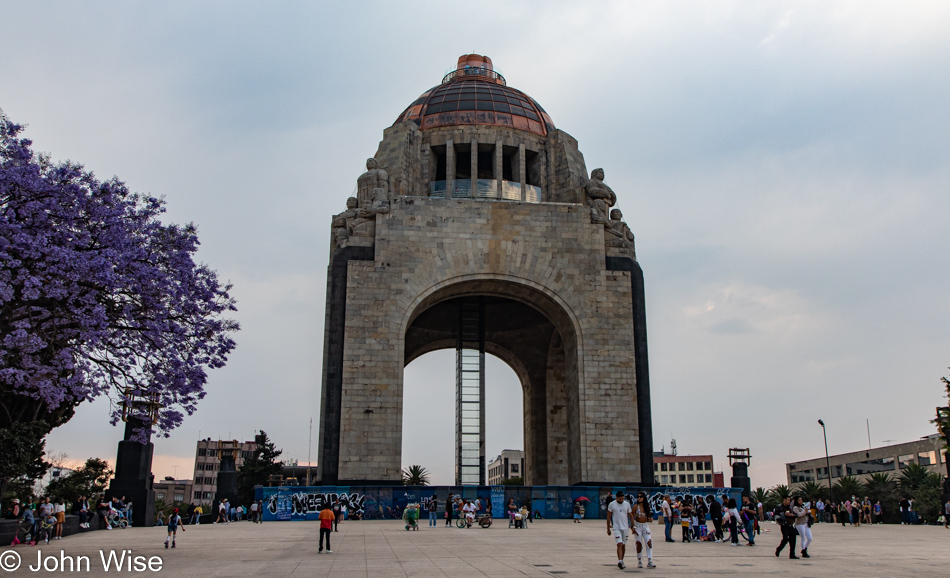
Monumento a la Revolución, or Monument to the Revolution, celebrates exactly that: the Revolution for Independence from Spain fought between Sep 16, 1810 – Sep 27, 1821.
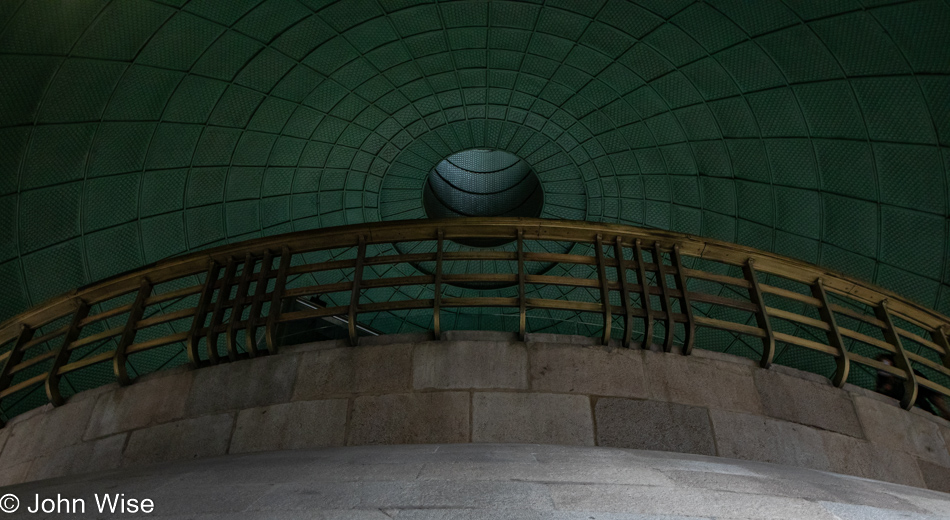
Believe it or not, we didn’t see it until we were nearly upon it, and then all of our wishes moved to hoping it would still be open long enough for us to ride the elevator up the center of the monument.
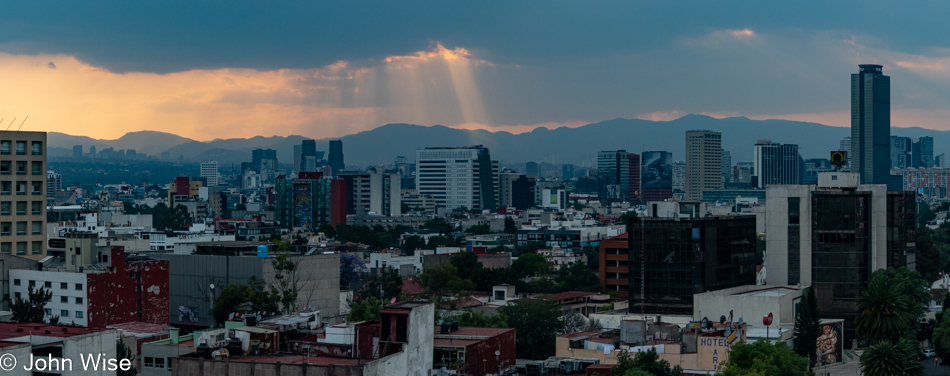
The view from up here is amazing and should be witnessed for not only the sunset but the sunrise too.

There’s a small museum under the monument, but not a lot of information for us English speakers. Most likely, visitors are well familiar with their own history here.

Looking straight up into the monument, the blue frame glass thing is where the elevator takes visitors.
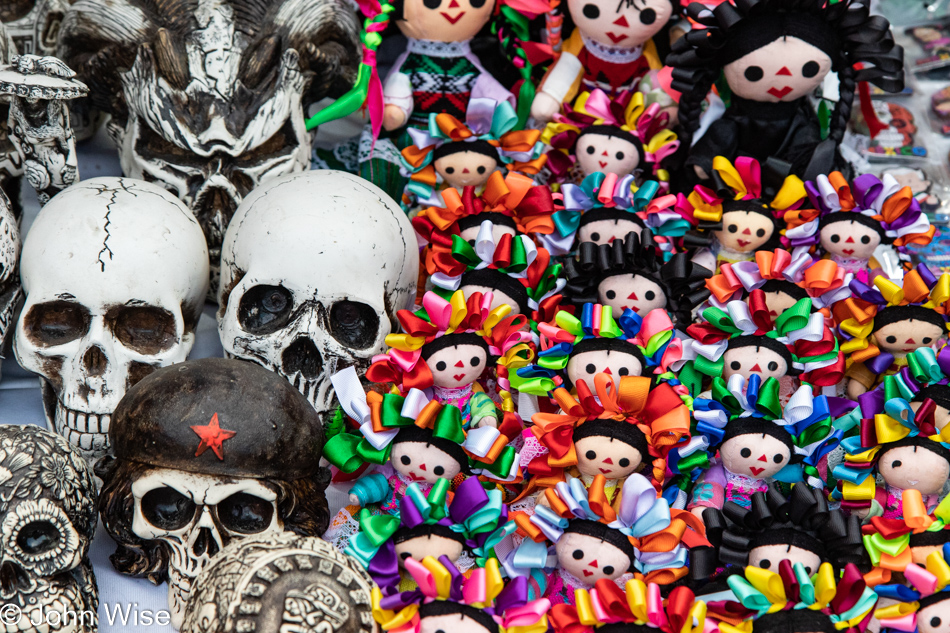
Vendors selling trinkets celebrating the revolution line one of the walkways, but we are hesitant to buy anything at all, considering the textile side of our journey in Mexico that starts soon down in Chiapas.
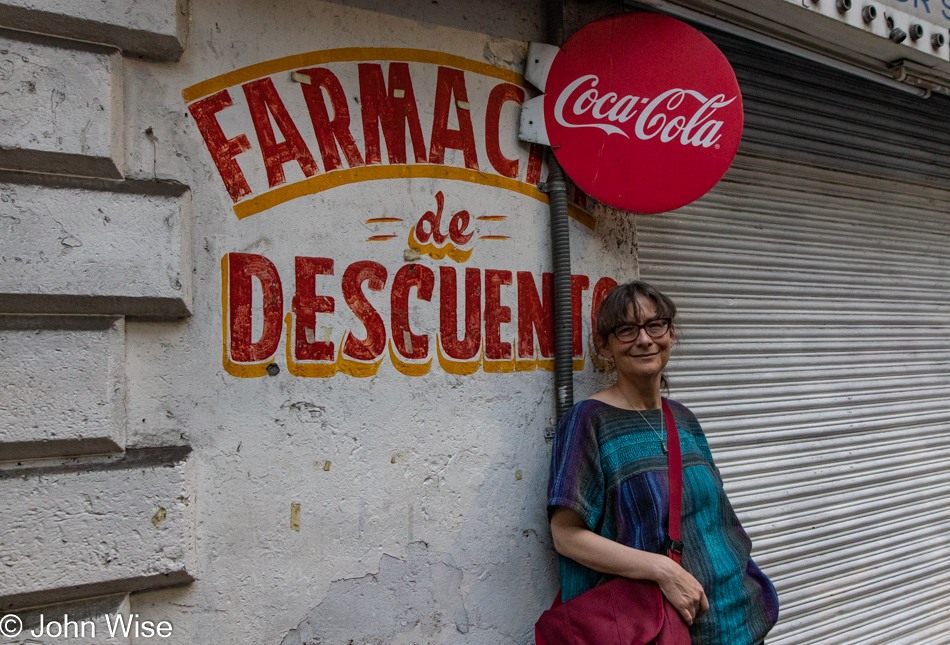
Remembering to take photos of ourselves in this environment is tough as we’d rather everything reflect where we’ve been, but having a photo or two to prove we were actually here isn’t a bad thing.
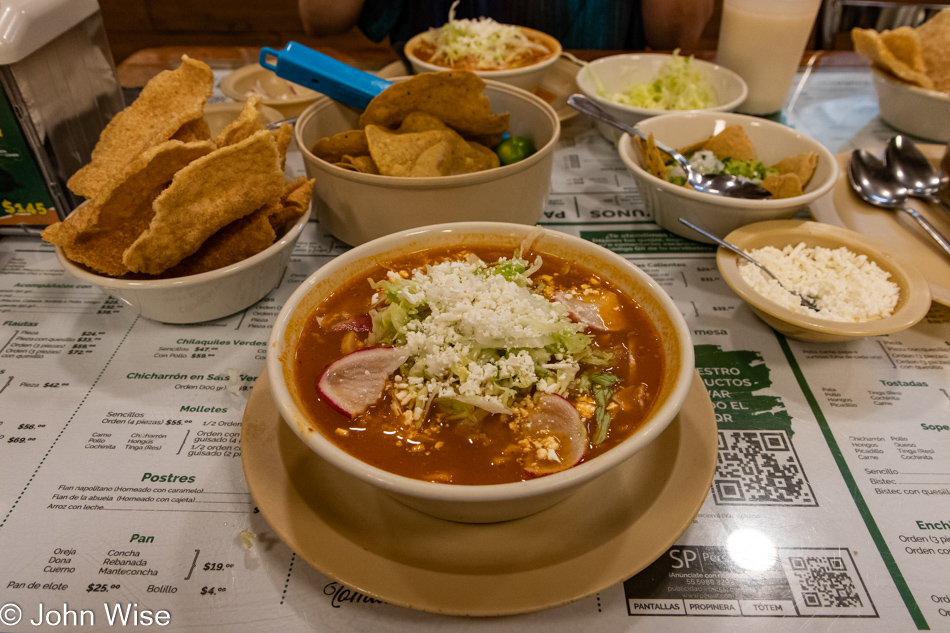
Attention readers: it’s nearing 11:00 pm, and I’ve selected and prepped 71 of nearly 500 photos. I’m posting all 71 here, mostly without text, for you to see my process, as this is a work in progress. My goal of finishing a blog a day while we are in Mexico is already off to a bad start; who knew there would be so much to see here on a Sunday?
I’m leaving the paragraph above, though, as I move to finish this post here on March 26. It’s a bit superfluous, but it is a note in our history of how things play out. Our incredibly inexpensive dinner that had to be noted was for bowls of posole from La Casa de Toño. What was so special about this meal? That bowl of pork posole was under $4.00, and Caroline, who had a small bowl with chicken, was barely over $3.00. We ran into this place by pure chance. Coming around a corner, we saw a long line of people waiting in front of a small restaurant. Assuming they knew something we didn’t, we got in line, only to find out that the Peruvian family in front of us spoke a little English, and between that and our minuscule Spanish, we were able to have a great conversation during our wait.
Like I said with the title, Mexico City is Estupdendo!